




If you haven’t been back to IUP lately, I hope you get a chance soon. If you have come back, I hope you are glad you did.

For many alumni, the IUP campus probably doesn’t look the way they remember it. The dorms, for the most part, have been upgraded to suites. Some academic buildings have been razed, replaced with new ones that carry new names. But while the campus looks different, the goal of providing our students a first-class education remains the same.
As IUP approaches its 150th anniversary, we have big plans on the horizon, one of which—a proposed college of osteopathic medicine—you can read about in the pages ahead. But having those big plans requires adaptability and f lexibility. Technology changes rapidly, too, and for our students to thrive, they need state-of-the-art facilities.
Our latest project is the construction of John J. and Char Kopchick Hall, which will open in January, replacing Carl S. Weyandt Hall as the home of the Kopchick College of Natural Sciences and Mathematics. Designed using input from faculty, students, staff, alumni, and the scientific community, the 142,000-square-foot Kopchick Hall will give our students opportunities for discovery and knowledge sharing that similar universities can’t offer.
That’s why we built Weyandt Hall six decades ago and why we continue to look at all our facilities to see what can be updated or replaced to give our students advantages. We’re using our history to inspire us as we move forward, not as a static base on which we rest. That means change will be, and has to be, constant.
We can still remember the IUP we knew and can still look ahead to the horizon, at the IUP of the future, knowing that change affects only the days ahead, and not the days gone by.
Today, at IUP, we are excited about what’s to come. I hope you share in our enthusiasm, because tomorrow is a destination we are chasing together.
That’s something that will never change.
Michael Driscoll President
A Fashion Studies professor shares observations on apparel chronicled in yearbooks.
See which eight graduates earned the alumni association’s top honor in 2023.
IUP explores opening a college of osteopathic medicine to address the region’s physician shortage. Soon-to-be-razed Weyandt Hall was once a top science facility. An educator’s love of Indianaarea eateries
math
Students headed for the hotel industry can practice in class, behind a real-life front desk.
ABOVE: In August, the Student Cooperative Association opened an esports arena on the upper level of the Hadley Union Building. Esports are competitive and feature multiplayer video games. IUP has had an Esports Club since 2019.
COVER: Can IUP help remedy the physician shortage in rural Pennsylvania? Coverage begins on page 8. Illustration by John Ritter ’88.

PRESIDENT OF INDIANA UNIVERSITY OF PENNSYLVANIA: Michael Driscoll
EDITOR: Elaine Jacobs Smith ’93
CONTRIBUTING EDITORS: Karen Philippi Gresh ’67, Bob Fulton ’75
NAMEDROPPERS EDITOR: Matthew Burglund ’98
ALL ABOUT ALUMNI EDITOR: Jason Levan ’97
DESIGN: Meghan McMeans Strittmatter ’13
PHOTOGRAPHY: Brian Henry
IUP Magazine is published by Indiana University of Pennsylvania, a member of Pennsylvania’s State System of Higher Education.
The magazine’s address is John Sutton Hall, Room 301, 1011 South Drive, Indiana, PA 157051046 (telephone 724-357-3112; email iupmagazine@iup.edu). Correspondence regarding any aspect of the magazine may be directed to this office. Print and web images derived from photos submitted for publication become the property of Indiana University of Pennsylvania and may be reprinted at the discretion of the university.
IUP Magazine welcomes contributions to help defray the cost of publishing. The Official IUP Magazine Form may be used for this purpose.
©2023 by Indiana University of Pennsylvania. All rights reserved.
Indiana University of Pennsylvania is an equal opportunity/affirmative action employer committed to excellence through diversity.
WEB
When Phi Mu Alpha music fraternity needed an advisor in 1979, marching band director Charles Casavant stepped up. But first, he had to pledge the fraternity. Mary Kreider Megna ’84 shares the story at IUP.edu/phimualpha
WEB
Rosemary Gido, professor emerita of criminology, is still an active researcher, often focusing on how poverty affects the incarceration rate. Read about her ongoing work and how she has involved former students at IUP.edu/rosemarygido.
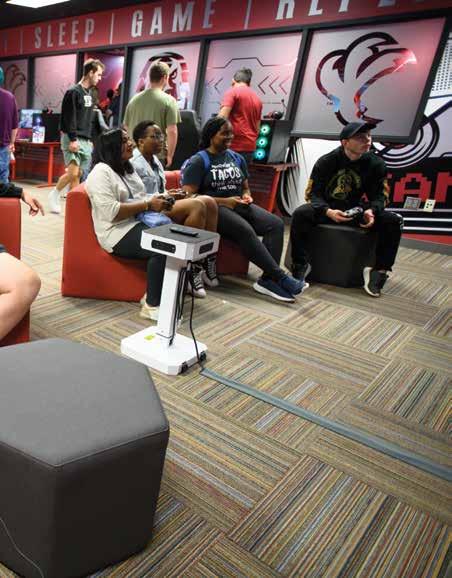
A professor in IUP’s Fashion Studies program, Janet Blood gave a presentation last spring on changes in style from the late 1800s at Indiana State Normal School to the 1940s at Indiana State Teachers College. Following are some of her observations from yearbooks. Images were provided by IUP archivist Harrison Wick.
frills around her neck and shoulders are likely part of a capelet the preceptress is wearing over just a bodice with leg-of-mutton sleeves and a long walking skirt, Blood said. These sleeves were most popular in 1895, but fashion tends to move slowly into rural areas like Indiana, she said.
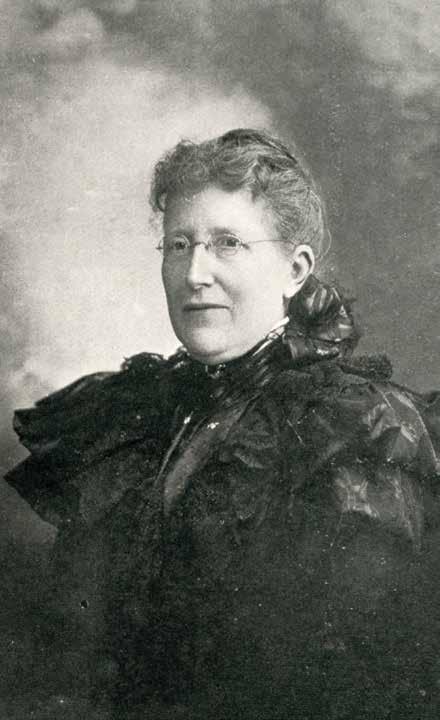
Phi Alpha, 1912—Their suits “look like you could get them off the rack today,” Blood said, which is common in men’s clothing, although the width of ties, lapels, pant legs, and jackets changes over time. The stiff, detachable collars helped shirts look clean longer.


The silhouettes of these garments show a shift in eras from Titanic to World War I, Blood said. Walking skirts are rising. Women are wearing cardigans, “whether they’re theirs or their beaus’.” War is a strong influence on fashion, she added, giving the examples of trench coats and the switch from pocket watches to wrist watches.
Garments began moving to boxy, barrel silhouettes while hemlines started to rise. Some freshmen are holding onto their piledhigh, Gibson Girl hairstyles, Blood noted, while others have moved on to wearing their hair down or pulled back.


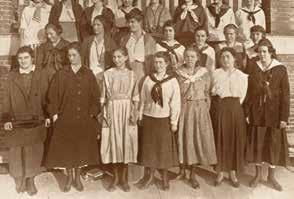
These students “seemed at the forefront of style,” Blood said. Bob cuts and Marcel waves were becoming popular hair trends.

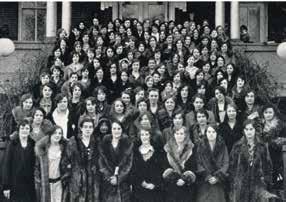
Donning furs on a chilly day were members of the Primary Grade of Indiana Club, for students preparing to teach in elementary schools. “Furs were probably less exclusive than they are today,” Blood said.
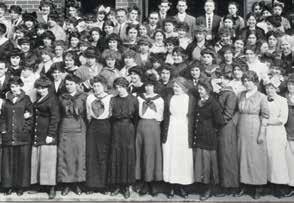
Garments cut on the bias—with the pattern at a 45-degree angle to the fabric’s weave— created a smoother fit that hugged or softly draped the body. The technique started in the 1920s and remained popular throughout the ’30s, Blood said, pointing to these examples.
Indiana Pulchritude, 1940—In the 1920s through the ’40s, many yearbook pages were devoted to beauty (or pulchritude). While pursuing the “ideals of beauty” is a controversial topic now, Blood said, “sometimes it’s a losing battle because it’s so engrained within our society.”



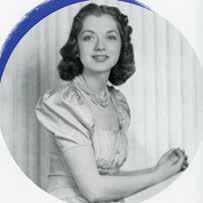 Newman Club, 1933
Sophomore Class Officers, 1938
Junior Class, 1913
Freshman Class, 1918
Art Club, 1926
Newman Club, 1933
Sophomore Class Officers, 1938
Junior Class, 1913
Freshman Class, 1918
Art Club, 1926
Athletic uniforms dating back to the late 1800s look similar to outfits people wear today—inside and outside of sports, particularly on the men’s side. “It’s neat to see how sports wear turned into sportswear,” Blood said. “There’s a reason for that.”
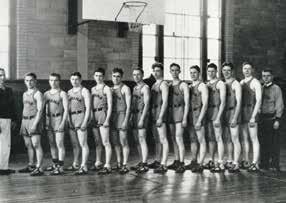

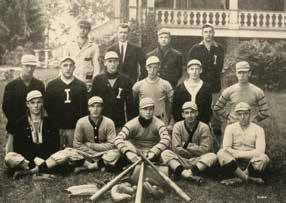
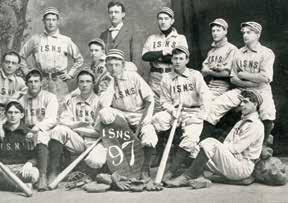


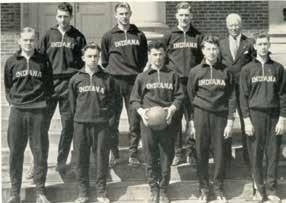
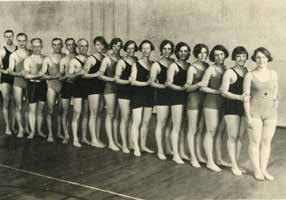
Historic Costume Collection welcomes donations of key apparel and accessories from all decades, particularly the 1990s through the 2010s.
Contact: Dr. Janet Blood janet.blood@iup.edu
Synthetics were just coming out at this time, so these suits would have been wool, Blood said. “Wool doesn’t absorb water right away. It stays on the surface. I don’t know how it felt on the body.”
“You could walk out of the Co-op Store today” with these quarter-zip sweats, Blood said.
The university community is grateful for the following gifts and pledges of $25,000 or more, made to the Foundation for IUP between January 1 and June 30, 2023.

James Self ’65 and Jamiela Self, a planned gift of $1 million to establish the Jim and Jamie Self Brass Scholarship for students pursuing a degree in music with a concentration in brass
The Estate of Robert Flora M’78, an estate gift of $200,000 to establish the Robert T. Flora Memorial Scholarship for students from Cambria County pursuing a degree in counseling or psychology
Douglas Roblin ’75, a combined planned gift and gift of $125,125 to the Douglas Roblin Award Fund, which supports projects administered through the Department of Anthropology and the Madia Department of Chemistry, Biochemistry, Physics, and Engineering
Benjamin Keltz ’77 and Frances Costanzo Keltz ’76, a planned gift of $85,000 to establish the 1976 Alumna Food and Nutrition Scholarship for students pursuing a degree offered by the Department of Food and Nutrition
An anonymous planned gift of $75,000 to the Rita M. Johnson Legacy Scholarship for students pursuing a degree offered by the Department of Food and Nutrition
Raymond Mialki, a combined gift, pledge, and planned gift of $68,803 to support the IUP Criminal Justice Training Center and to establish the Criminal Justice Training Center Fallen Officer Memorial Fund, which
supports the IUP Criminal Justice Training Center
Quest for the Best, a pledge of $66,700 to the Municipal Police Academy Scholarship for students enrolled in the IUP Criminal Justice Training Center The Beaumont Foundation, C. Edward Keller ’74, and Judy Keller, a gift of $60,000 to support the C. Edward Keller Scholarship in Criminology and Criminal Justice for students majoring in criminology
Susan Wheatley, a combined gift of $52,000 to establish the Daniel Perlongo Music Award, which provides scholarship support to students pursuing a major in the Department of Music with a concentration in music composition or piano
Daniel Radakovich ’80 and Marcie Radakovich, a pledge of $50,000 to support IUP football and the Dan and Marcie Radakovich Football Scholarship for participating members of the IUP football team
Nick Jacobs ’69, M’72 and Mary Ann Hoysan Jacobs ’68, M’93, a gift of stock totaling $40,431 to support the creation of a college of osteopathic medicine
Glenn Fitzgerald ’69, a combined gift of $35,681 to the Kathleen Rankin Fitzgerald Scholarship for Elementary Education for students pursuing an elementary education degree and the Glenn Fitzgerald Scholarship for Natural Science for students pursuing a natural science degree
Nadav Baum ’86 and Nancy Wallace Baum ’83, a pledge of $33,000 to the Eberly College of Business Dean’s Innovation Fund
The Robert and Nellie Reynolds Fund, a gift of $30,987 to the Student General Scholarship Fund. Both Robert Reynolds and Nellie Byers Reynolds were with the Class of 1948.
Micheal Madigan ’80, M’86 and Elaine Taraba Madigan ’80, a gift of art valued at $25,600
Stephen Abel ’73, a combined gift of $25,300 to the IUP Veterans Assistance Fund, Army ROTC Fund, Fund for IUP, Donor Challenge, Geography and Regional Planning Department Enhancement Fund, History Department Enhancement Fund, and the Dean’s Innovation Funds for the Kopchick College of Natural Sciences and Mathematics, the College of Arts and Humanities, and the College of Education and Communications
Douglas Niesen ’87 and Heidi Niesen, a gift of $25,220 to support IUP football
An anonymous gift of $25,053 to the Dr. Lou Sutton Track and Field and Cross-Country Scholarship for full-time students who are members of the men’s track and field or cross-country teams
Poom Sunhachawi-Taylor ’87 and James Taylor ’86, a pledge of $25,000 to support IUP women’s tennis
Eleanor Mihalyi Gallati ’54, a gift of $25,000 to the Kopchick College of Natural Sciences and Mathematics Building Fund
An anonymous gift of $25,000 to support IUP volleyball

 By Mary Ann Slater
By Mary Ann Slater
When Rich Caruso ’83, an accounting graduate and Foundation for IUP board member, heard IUP was looking into opening a college of osteopathic medicine, he was initially skeptical.
That changed when his 101-year-old mother became ill and struggled to find adequate care at a small community hospital in northwest Pennsylvania. The family couldn’t find a local doctor and was able to receive help only through telemedicine in Pittsburgh.
The experience frustrated Caruso, a Kane native now living in Meadow Lands. In April, when he came to campus to accept IUP’s Distinguished Alumni Award, he surprised the audience by announcing he was giving a million dollars, in his mother’s honor, toward establishing the medical college.

“The shortage of doctors in the state is troubling,” he told the audience. “The shortage of community doctors is totally unacceptable.”
The Caruso family’s experience, a common one in rural Pennsylvania, illustrates the healthcare crisis IUP aims to address with its proposed college of osteopathic medicine. Last December, the university’s council of trustees gave approval to exploring the venture.
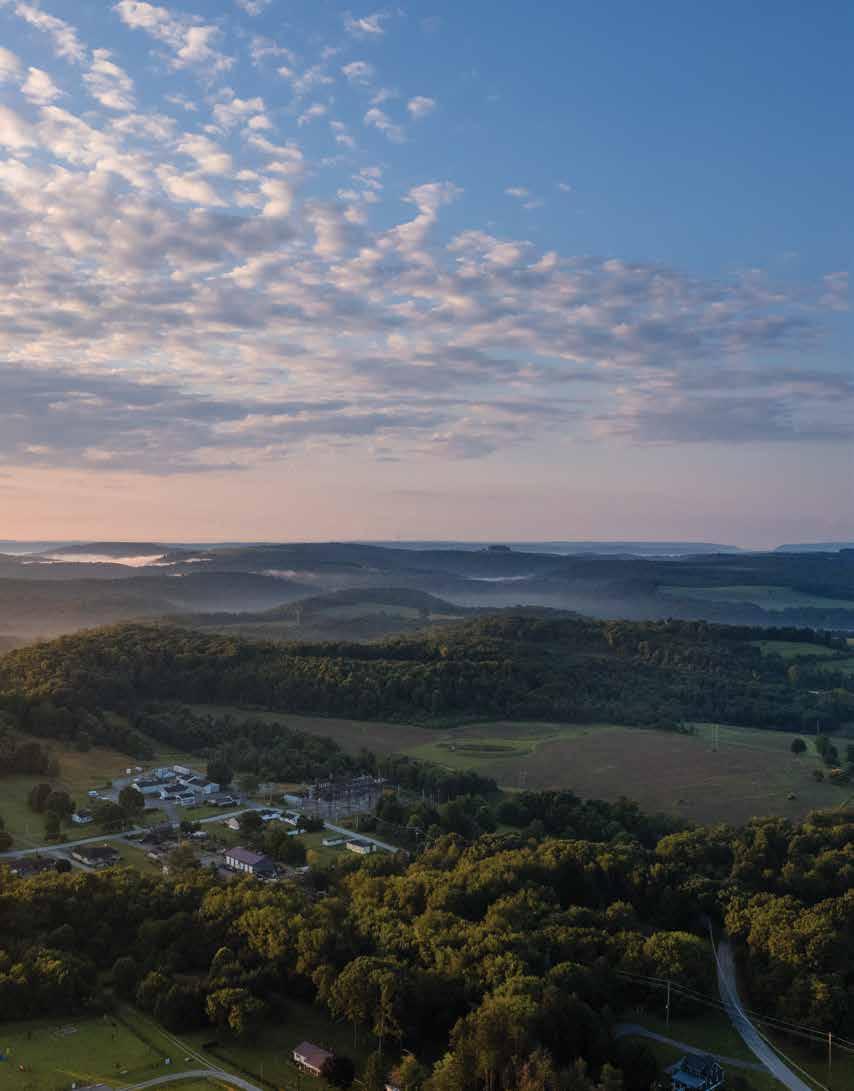
“Workforce has been an intractable issue in rural health,” said Lisa Davis, director of the Pennsylvania Office of Rural Health, which works to ensure access to high-quality, affordable care. “It’s not just physician shortages; it’s all healthcare provider shortages.
“For primary care, it’s difficult to attract and retain, because of what are viewed as challenging characteristics of rural communities,” she said. Primary care is a physician specialty that encompasses family medicine, general internal medicine, and general pediatrics.
Davis said some providers consider rural areas too isolated, with limited opportunities for their partners and children. Shortages have become more acute since the pandemic, with doctors retiring early or leaving the profession because of burnout.
The lack of primary care doctors is most pronounced in Pennsylvania’s northern
tier and in parts of its midsection, according to the Health Resources and Services Administration, an agency of the US Department of Health and Human Services.
Primary care physician Amanda Vaglia, DO, directs Indiana Regional Medical Center’s Rural Family Medicine Residency Program. Previously, she worked at a private practice in Clymer that served a wide rural area and was always busy. She said she and her colleagues worked hard to meet patients’ needs, but squeezing in new patients became challenging. When primary care becomes less available, people who don’t have an established doctor can wait longer for appointments, sometimes getting sicker in the meantime.
The problem will only grow as Pennsylvania’s population gets older.
“At the same time that we are gaining more aging patients, many of those seasoned, very experienced physicians are also going to be moving toward retirement,” Vaglia said. “We are already operating at a deficit of primary care physicians. It is only going to worsen. Everyone across the nation with whom we collaborate is dealing with exactly the same thing.”
Against this backdrop of rural health problems, leaders of IUP and Indiana
According to the Health Resources and Services Administration, the areas in blue have shortages in primary care physicians, and the areas in yellow have more severe shortages (from north to south, parts of Potter and Tioga counties, Clinton County, Armstrong and Indiana counties, and Huntingdon, Bedford, and Fulton counties).

Regional Medical Center began discussing potential collaborations to benefit the region.
Some of those partnerships, such as IUP Biology chair Narayanaswamy Bharathan’s assistance to IRMC with rapid COVID-19 testing, have been featured in another joint project, the coproduced podcast Rural Health Pulse
Talks between Michael Driscoll, IUP president, and Steve Wolfe, the medical center’s CEO, began by focusing on some of the institutions’ strengths.
For the university, those included an array of science and health programs, such as the PhD in nursing and programs in dietetics, nutrition, and exercise science, as well as construction of a new science building, John J. and Char Kopchick Hall, set to open this spring.
Also known for its research, IUP is one of only 93 public universities in the US with a “high research activity” designation from the Carnegie Classification of Institutions of Higher Education.
IRMC’s strengths included launching the residency program that Vaglia now directs. The program accepted its first class of residents in July 2022; the second class began this past July. The medical center also recently started a summer internship program for area high school and college students. New trends in physician recruitment emphasize the importance of attracting rural youth to medicine, Vaglia said, because when these students go on to medical school, they are much more likely to return to a rural area to practice.
From that assessment of strengths and the understanding of rural healthcare’s challenges, the idea of opening a medical college was born.
“It is clear that there was and is a challenge to getting adequate numbers of healthcare professionals, particularly to rural areas,” Driscoll said. “If we can find a way to bring more physicians into rural areas to practice, Indiana County would benefit a great deal, and many other rural areas in the commonwealth and in the country would benefit as well.”
Last year, the university hired Tripp Umbach, a longtime consultant to new and expanding medical schools, to explore the feasibility of opening such a school at IUP.

“They came back and said we were ready to do this,” Driscoll said. “It’s not that it is easy, building a medical school, but we were on the path. We had the basics in place.”
A college of osteopathic medicine, in particular, would address two key needs for the area, the consultant said. Graduates of these colleges are more likely to practice in rural and underserved areas than are graduates with doctor of medicine (MD) degrees. They are also more likely to practice primary care.
Richard Neff, MD, chief medical officer at IRMC, agrees.
Osteopathic medicine is known to embrace a holistic approach to caring for patients and to focus on preventive care. Doctors of osteopathic medicine (DOs) are licensed physicians who prescribe medication and perform surgeries, just like MDs.
However, while MDs tend to pursue medical specialties and research, Neff said, DOs more often go into primary care.
“Osteopathic schools have a strong history and a proven track record of producing primary care physicians,” he said.
Recent statistics support this. In 2020-21, 57 percent of practicing doctors of osteopathic medicine were in primary care, compared to 28 percent of active doctors with MD degrees, according to the American Osteopathic Association and the Association of American Medical Colleges, respectively.
In addition, six of the 10 US medical schools that produce the most primary care residents are colleges of osteopathic medicine, U.S. News & World Report found in 2022.
Regarding where doctors choose to practice, Neff said most MD schools and residency programs are in urban settings. Doctors educated and trained in urban or suburban areas often practice in those areas, because they feel like home.
“It is well documented that students and residents have a strong predilection to work close to where they are trained,” Neff said.
A medical college at IUP would help reverse that trend by showing students the benefits of working in a rural area.
Daniel Kupas, DO, a 1988 graduate of IUP’s Biology/Pre-medical program, completed his medical degree at Philadelphia College of Osteopathic Medicine and his residency at what is now UPMC Community Osteopathic in Harrisburg. For years, he has practiced family medicine in the Kiski Valley, where he grew up and acquired a love of the medical field. As a Boy Scout, he earned a merit badge in first aid, and as a teenager, he volunteered for Lower Kiski Ambulance Service. He is now the service’s board president.
Kupas believes a college of osteopathic medicine at IUP could help with recruiting rural doctors, in part because students are likely to get involved in the community while pursuing their degree.
“They may still be doing other volunteer work,” he said. “There is a good shot at potentially retaining some students of Pennsylvania who want a good-valued medical school education.”
The state currently has two colleges of osteopathic medicine; a third, at Duquesne University, is expected to open in 2024. All are private. IUP’s proposed college would be the first in Pennsylvania to offer the relative affordability of a public institution.
“It is certainly a very exciting opportunity for those who are looking to attend medical school and become physicians,” Kupas said.
Community leaders, state and local government officials, and area representatives from Congress have been supportive of the proposed college, which is expected to provide a significant economic boost. Tripp Umbach projects $66.7 million in total economic impact and $2.7 million in total state and local government revenue when the school is complete. Under a multiplier effect, 420 new jobs would be created within the community and the region, the consultant estimates.
In addition, an IUP college of medicine is expected to strengthen the university’s existing high-quality science and healthrelated programs and to attract more students interested in healthcare in general. Currently, 30 percent of IUP students are enrolled in science, technology, engineering, math, and healthcare (STEM-H) programs.
One of the university’s first steps toward establishing the college is to hire a founding dean. Interviews for the post took place in the summer. Next, IUP will start the lengthy but necessary accreditation process through the Commission on Osteopathic College Accreditation.
University officials are also seeking clinical partnerships with hospitals around Pennsylvania to serve as rotation sites for third- and fourth-year medical students and as residency sites for the college’s graduates. During rotations and residencies, experienced doctors serve as mentors for physicians in training.
Clinical partnerships with rural medical providers will be crucial, Driscoll said, as they are “key to attracting physicians to stay in those rural areas.”
IRMC and other members of the Pennsylvania Mountain Healthcare Alliance, a consortium of independent rural hospitals that work together on common needs, have expressed interest in providing clinical experiences to IUP medical students.
“We are very excited to work with IUP on this big vision,” Wolfe said. “We are trying to work with all of those hospitals to see if we can get additional clinical sites.”
Driscoll hopes other schools in Pennsylvania’s State System of Higher Education, some of which are in rural areas, can also identify hospitals that may be able to offer clinical experiences.
Projected start-up costs for the medical college over the next six to eight years are $102 million, which includes money for facilities, an operating budget, and an escrow account that has to be maintained until the college’s first class graduates. That funding must be new, Driscoll said, and not from IUP’s budget for existing operations. The university is seeking state and federal funds as well as support from private, corporate, and foundation donors.
Driscoll knows IUP has a long road ahead to make its vision for a college of osteopathic medicine a reality. He perseveres because he believes IUP can play an important role in improving access to healthcare for rural residents.
“It’s a big problem,” he said. “And here we sit, in a rural area, with all the pieces we need to create a medical college to help fix that problem. I want us to build a model for medical education and rural health that other states can look to and duplicate.”m
• Provider shortages affect all positions, not just doctors. The American Hospital Association predicts the nursing deficit will reach half a million by 2026. See how IUP is preparing nursing students—and the educators who teach them—at IUP.edu/ nursingshortage
• Rural Health Pulse, a collaborative podcast by IUP and Indiana Regional Medical Center, has covered topics that range from the institutions’ partnership on same-day COVID-19 testing to IRMC’s family medicine residency program to the services IUP’s Speech, Language, and Hearing Clinic provides the community. Episodes were added monthly from November through August. Listen at IUP.edu/ ruralhealthpulse
 By Bob Fulton
By Bob Fulton
Amassive, multimillion-dollar science complex is rising on the edge of the Oak Grove, a new home for those who teach and those who study biology, chemistry, physics, geology, astronomy, botany, zoology, oceanography, and more.
Kopchick Hall? Well, yes. But the paragraph above could just as easily have been written in 1966 about Weyandt Hall, a state-of-theart facility that wowed the IUP community
at its unveiling. It was the Kopchick Hall of its time.
“Weyandt Hall represents one of the most significant instructional advances in the development of the university,” IUP’s president, Willis Pratt, said back then.

Pratt presided over the building’s dedication on October 15, 1966— Homecoming weekend—only 22 months after a groundbreaking ceremony at
which he turned the first spade of earth. Administrators, faculty, and students marveled at this gleaming, $3.7-million addition to the campus landscape.
“It was a bright, shining star,” said Steve Hovan, dean of the Kopchick College of Natural Sciences and Mathematics. “At that time, it was unusual for a school to put up a building solely for the purpose of all the sciences, and bringing them together.”
Before Weyandt, science students and faculty were scattered across campus. Walsh Hall was originally designed to be the science hub, but it was undersized and unable to accommodate a burgeoning university population.

“Walsh never really fulfilled its mission to be a science building,” Hovan said. “Leonard Hall still maintained biology and some of the chemistry labs. But even with all the space between what was in Leonard and what was in Walsh, it couldn’t begin to compare with Weyandt, which was just a huge building, maybe one of the biggest in what eventually became the State System. I think it would have been transformative at that time to go from very small labs and very cramped offices to having a place dedicated just for the purpose of science that had abundant space.”
Science faculty and students accustomed to bumping elbows in near-claustrophobic conditions welcomed Weyandt’s roominess.
“Increasing the total instructional space now available on campus by as much as a full third to a half over what it had been, Weyandt Hall contains approximately 142,000 square feet and could hold as many as 2,500 students at one time in the approximately 85 classrooms and laboratories,” noted the December 1966 Alumni News Bulletin. “Included in this number are classrooms seating 150, 100 or 48 students in large lecture rooms as well as smaller conference or seminar classrooms. … Offices for approximately 50 staff members are of two types—individual faculty offices for desk work and class preparation, and research office areas for conducting faculty, graduate student and advanced graduate student research.”
The emphasis on research space was a game-changer. Faculty focus could now shift from strictly teaching to a blend of instruction and research.
“That’s what was really different about this building,” Hovan said. “Up until that point, all the space for the sciences was really for teaching the sciences. So there were teaching classrooms, or there were small lab areas that were designed for students to learn. But it was all for teaching. The new building had spaces that were specifically for faculty research. There was still a lot of teaching space, too, but for faculty to have their own research lab and to have space to conduct their research and have students become involved in that was really kind of special.”
What’s more, students now had access to cutting-edge technology. The new building featured a planetarium, at the time “an unusual piece of equipment for science on most campuses,” Hovan pointed out; a weather station situated on the roof that recorded temperatures, relative humidity, atmospheric pressure, and even solar radiation; a Van de Graaff accelerator that generated artificial radioactivity; and, in the basement, one of the few seismometers located on the campus of a Pennsylvania university.
“The only other operational seismic stations [in the state] that I know of were at Penn State and Pitt,” said Fred Park, a member of the chemistry faculty when Weyandt first opened its doors. “And IUP had a dandy, because we were sitting geologically in a very nice location in terms of being able to propagate signal strength through the Earth’s crust.”
Advanced equipment of that nature bolstered IUP’s reputation as a leader in the sciences, as did a sudden surge in faculty numbers.


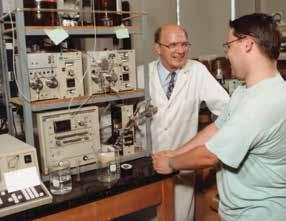
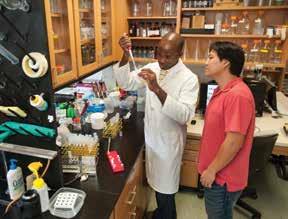
“At that time there was a plethora of science hiring, because we were in the moon race, among other things,” Park said. “And there was federal money coming into the operation. So when Weyandt was opened, that was just about the time IUP was able to hire more faculty in the sciences than I think it ever did—later or before that.”
Weyandt Hall was, as Hovan noted, a bright, shining star back then. Alas, the star has dimmed considerably over time. New spots invariably appear on the ceiling after rainstorms, the plumbing system occasionally backs up, and ominous cracks are visible throughout the building.
“At that time, it was unusual for a school to put up a building solely for the purpose of all the sciences, and bringing them together.”
“I would like to say I’ll miss Weyandt,” said Hovan, who was a faculty member in the Geoscience Department for 26 years. “I will definitely miss what it means for the students and the faculty and the network of people I’ve gotten to know through the years. I have very fond memories of talking science with others. But I’m not going to miss the mechanical tiredness of the building. I’d be the first one to take a sledgehammer to it to bring it down.”
Fortunately, Hovan can look forward to the opening of Kopchick Hall in the spring of 2024, just as members of the science faculty looked forward to their move into Weyandt Hall in the fall of 1966.
“I can only imagine how excited they were,” Hovan said, “because it was a fairly large building. It’s still one of the biggest buildings on campus. So to have something like that 50 years ago, there had to have been an anticipation and an excitement to see it grow from the ground up. Much like we’ve been excited watching from a distance as Kopchick Hall grows from the ground up.”
Kopchick Hall, opening in January 2024
John Weyandt knew this day would come. That doesn’t make it any easier for him and his family.
The building named for his late father, Carl, will soon be razed, with IUP’s science programs moving to nearby Kopchick Hall.

“I have kind of mixed feelings,” said Weyandt, who earned bachelor’s (1967) and master’s degrees (1969) in history from IUP. “Certainly we’re going to miss it. On the other hand, the people there at the university deserve an upgraded building. I’m glad IUP honored my dad, but it’s time for it to be replaced.”
Carl Weyandt—industrialist, inventor, businessman, philanthropist, civic leader— was born in Duncansville, grew up in Ellwood City, and graduated from Carnegie Tech (now Carnegie Mellon University) in 1917 with a degree in electrical engineering. Weyandt founded the Syntron Company in Pittsburgh four years later and soon after
was awarded a patent for his electric hammer, which became Syntron’s signature product. Other patents related to Syntron products followed. He moved the company to Homer City in 1937 and remained its president until retiring in 1960.

Weyandt served on Indiana State Teachers College and Indiana State College’s board of trustees from 1958 until his death on October 16, 1964, and made significant contributions to what in 1965 became the university, among them annual scholarships granted students through Syntron.
“I know it was his policy at Syntron to provide scholarships for students, and that carried on for a long time,” John Weyandt said. “He came from a generation of people who felt a responsibility to the community.”
Because of his unwavering support of what became IUP after his death, the board of trustees designated the school’s new science building Carl S. Weyandt Hall. But what once was hailed as a state-of-the-art facility is now showing its age. A date with the wrecking ball looms in the not-too-distant future.
“It’s kind of a bittersweet feeling for us,” Weyandt said. “But people will remember the building. They’ll remember my dad. And that’s something that makes us feel good.” m
Waleed Farag, a professor of computer science and director of the Institute for Cybersecurity, received the Distinguished Faculty Award for Research. He joined the faculty in 2002.

Ben Ford, professor of anthropology, is IUP’s latest Distinguished University Professor, a title he and past award recipients will hold for life. A member of the faculty since 2009, Ford has chaired his department for six years. His scholarship has focused on archaeology involving human interactions with oceans, lakes, and rivers and on historical archaeology, specializing in the frontier period of western Pennsylvania. This academic year, he plans to launch a project called Heritage Futures “to leverage heritage to heal past wrongs and foster a healthier future.” He will involve students, he said, to help them build research skills and become more caring and productive members of society.
Last spring, the University Senate presented the following awards:
Lynn Botelho, a professor of history and IUP’s 2011-12 Distinguished University Professor, received the Distinguished Faculty Award for Service. She joined the faculty in 1996.
Crystal Machado, a professor in the Department of Professional Studies in Education who joined the faculty in 2008, received the Distinguished Faculty Award for Teaching.
Sharon Massey, an associate professor of art who joined the faculty in 2011, received the Distinguished Faculty Award for Creative Arts.
Cindy Varner, a senior scheduling specialist and management technician in the Office of the Registrar, received the Distinguished Staff Award for Service. She joined the staff in 1999.
Amanda Poole, professor of anthropology, was selected for the Fulbright Specialist Program and will work with the Institute of Anthropology and Ecology at Catholic University of Madagascar.

At the May commencement ceremonies, Bonnie Harbison Anderson ’80 received an honorary doctor of science degree and gave the commencement address. Named an IUP Distinguished Alumna in 2012, she is cofounder and former CEO of Veracyte, a San Francisco-based molecular diagnostics company.



Steven Jackson, professor of political science, was awarded a nine-month fellowship at the Woodrow Wilson Center for International Scholars in Washington, DC.
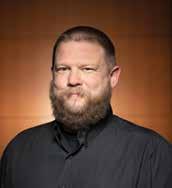
Shagufta Haque, a student in the Cook Honors College and Economics Honors Program, was appointed the student member of the IUP Council of Trustees, succeeding Maura King ’23

IUP presented its 2023 Award of Excellence for Outstanding Volunteer Leadership in four categories:
Advancement Support: Jerry Clark ’69, member of IUP’s Athletics Advancement Council, Boardwalk Bowl Football Endowment Campaign, and Athletics Hall of Fame
Regional Impact: Charles “Skip” McGreevy ’71, retired educator and educational consultant and longtime IUP volunteer
Affinity Services: Mary Kreider Megna ’84, member of the host committee for the marching band’s 100-year celebration and coproducer of Sustaining Grace documentary
Aspiring Alumni: Maura King ’23, Cook Honors College graduate, student member of the IUP Council of Trustees, and member of the IUP Ambassadors
Keynote speaker for the recognition event was Bergitta Edison Cotroneo ’80
The College of Education and Communications presented its 2023 Impact awards to Paula Kirkpatrick Andrei ’91, M’92, Angela Roudebush Petroff ’96, Brittany Pavolik Fleming ’11, M’12, D’15, Brandon Sousa M’17, Scott Vinosky ’17, M’20, and Jessica Kropp Cosby ’22
When IUP athletics director Todd Garzarelli looks at his 19 teams, 40-plus coaches, and more than 400 studentathletes, he sees a lot to be proud of. The Crimson Hawks won four Pennsylvania State Athletic Conference championships in 2022-23, and several teams competed in the national championships.
But Garzarelli also sees a lot of potential for bigger and better things.
“It was a very strong year for our student-athletes and for the coaches,” Garzarelli said. “Overall, we reached a very high level of success on the playing fields and in the classroom. Our goals are to win the conference, win the region, and then compete in the national championships. Those are our goals every year, in all our sports.”
IUP won conference championships in football and men’s golf in the fall, men’s basketball in the winter, and women’s tennis in the spring. The tennis team also won the regional championship. Individually, several runners,
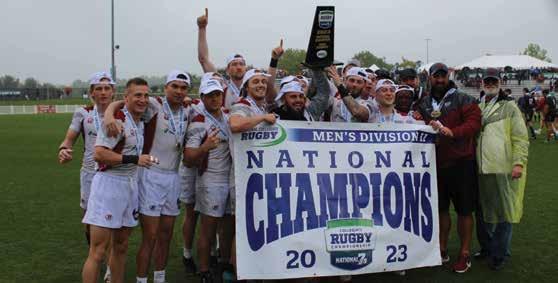
swimmers, golfers, and other athletes competed in the NCAA Division II championships.
It all culminated with the Crimson Hawks placing 36th nationally—and second among PSAC schools—in the National Association of Collegiate Directors of Athletics Learfield Cup, which ranks all 238 D2 athletics programs, based on each team’s success in the NCAA championships, across all sports.
“It’s the barometer by which we’re evaluated,” Garzarelli said. “It’s peer-to-peer. One of our goals as a department is to be in the top 50 overall.”
While finishing in the top 20 percent of the country is a great achievement for IUP, Garzarelli is more excited for what’s to come. He sees some programs on the verge of breaking out, and their emergence will make a great addition to the IUP teams that are traditionally strong.
“I do feel like we’re turning a corner in some sports that were stagnant the last few years,” he said. “We’ve had some coaching changes that have helped, and I think there will be more
championships for us in the near future.”
The Class of 2023 of the IUP Athletics Hall of Fame has 10 former student-athletes, two longtime athletic trainers, and one team—representing 10 sports in all. Members were inducted September 9. The 28th class is made up of Paul Bingham ’10 (baseball), Derrick Freeman (basketball), Michelle Jones ’07 (volleyball), Brianna Liebold ’11 (track and field), Donald Lindich ’65 (baseball and football), Chris Morgan ’08, M’09 (football), Jackie Rutkowski ’07 (lacrosse), Megan Woodall Mills ’01 (basketball), Kerry Yacamelli ’95 M’01 (football), and the late Nicholas Yutko ’83 (cross country), plus Ron Trenney ’84 and Frank Trenney ’92 (athletic trainers), and the 1968 golf team, which won the NAIA national championship.
The honorary Bell Ringer award went to Jack Frank ’58 and Jeannette Frank
Following the departure of longtime head coach Larry Peterson, assistant David Jacobs ’90 led the IUP women’s tennis team during the spring season and was honored as the Intercollegiate Tennis Association Assistant Coach of the Year and the ITA Atlantic Region Assistant Coach of the Year. In July, Andrew McGlashen was named the program’s head coach. Former all-conference women’s basketball player Lexi Griggs ’20 was hired in July as the director of Basketball Operations at North Carolina A&T University. In April, Dan Smay, former volunteer men’s basketball assistant coach, was named head coach of the men’s team at Penn State DuBois. George Boulos M’18 was hired in August 2022 as director of Basketball Performance at James Madison University. On the gridiron, Jim Hostler ’90 was hired as an assistant with the Detroit Lions after a three-year run with the Washington Commanders. The 2023 season will be Hostler’s 24th in the NFL. Former IUP assistant coach Tyler Haines was named the head coach at fellow Division II school Catawba (North Carolina). Jameson Zacharias, who was an assistant at IUP in 2017 and 2018, was hired as the cornerbacks coach at Division I FCS Richmond. Shaq Jones, who played at IUP in 2018 and 2019, has joined the coaching ranks as an assistant at Thiel College. Former IUP graduate assistant Anthony Piroli ’08 was inducted into the Beaver County Sports Hall of Fame in May. He has been head strength and conditioning coach for the Tampa Bay Buccaneers since 2019. Previously, he worked in the strength and conditioning programs for the Arizona Cardinals and for Mississippi State.
RUGBY’S REIGN—Last April, the IUP Men’s Rugby Club won its second straight National Collegiate Rugby Division II championship with a win over North Carolina State. The women’s club also traveled to Maryland for the tournament and finished as the country’s ninth-ranked D2 program.The list of former IUP studentathletes now in the coaching field is growing. Former baseball star Ryan Uhl ’17 is now an assistant coach at Gannon University; Mike Taylor ’95, former basketball player and later coach of the Polish National Men’s Basketball Team, is now head coach of the Winnipeg Sea Bears of the Canadian Elite Basketball League; Rebecca Tillett, a former assistant women’s basketball coach under Tom McConnell, this spring completed her first season as head coach of the Division I St. Louis University women’s team; former AllAmerican pole vaulter D. J. Horton ’19 is now an assistant track and field coach at St. Francis University; two-time PSAC champ Nickeela Austin ’20 works at Fordham University as an assistant track and field coach; and former IUP swimmer Dustin Steider ’14 recently marked the first anniversary of his appointment as the director of Sports Performance for Olympic Sports at Chicago State University.
Two recent IUP studentathletes signed contracts to play professionally in Europe. Dave Morris ’23, who was a key member of the men’s basketball team the past three seasons, signed with Ballincollig in the Irish Super League. In football, quarterback Mak Sexton M’23 joined the Wroclaw Panthers of the European League of Football after leading the Crimson Hawks to a 10-2 mark in 2022.
Former IUP rifle coach Thomas Campisano ’66, M’73, who was inducted into the IUP Athletics Hall of Fame in 2003, died March 10, 2023. He coached the IUP rifle team for 23 years before the sport was discontinued, then for 27 more as a club sport.
Recent changes to university leadership include the following:
In July, Stephen Ferris started as dean of the Eberly College of Business. A western Pennsylvania native, he previously served as dean of Ball State University’s Miller College of Business.
Also in July, Edel Reilly D’07, professor and provost’s associate for Academic Programs and Planning, became interim dean of the College of Education and Communications.
In August, Lynanne Black, professor and dean’s associate, became interim dean of the College of Health and Human Services.
The IUP Council of Trustees has approved the naming of several campus spaces:
In Cogswell Hall, the trumpet studio was named in honor of Kevin Eisensmith ’78, a professor emeritus of music who retired in 2022 after 23 years of service.
In recognition of Frank Condino, the athletics director
suite in the Kovalchick Complex will be named in honor and memory of his parents, Philip and Rose Condino, and former football player Thomas Michael Culhane CA’93. Frank Condino retired as athletics director in 2014 after nearly 30 years of service as a coach and administrator.
In Kopchick Hall:
• A classroom will be named in honor of retired biology professor Frank Baker and his family and in memory of his wife, Mary. Baker served on the faculty for 30 years.
• A classroom will be named in honor and memory of Walter Gallati, a professor emeritus of biology who retired in 1989 after 32 years of service. He died in 2020.
• A geoscience lab will be named in honor and memory of professor Walter Granata, who retired from the Geoscience Department in 1981 after 14 years of service. He died in 2013.
• The dean’s suite will be named in honor of Deanne Snavely, a dean emerita who retired from the Kopchick College of Natural Sciences and Mathematics in 2021 after a decade of service.
I was pleased to read in the latest IUP magazine about the festivities surrounding the 100th anniversary of the IUP Marching Band. I was disappointed, however, that both the event’s organizer and the author failed to recognize the significant contributions of Professor Emeritus Charles A. Davis to the organization. Throughout the ’50s, ’60s, and early ’70s, Davis ’34, a member of the Music Department, arranged music for the band’s halftime shows when Dr. Daniel DiCicco was the director. He was famous for his choral arrangement of the IUP alma mater (sung a cappella by the band). And who can forget his rendition of “Sing, Sing, Sing”? Alumni who participated in the marching band during these years would surely appreciate having him remembered. I am also aware that, unfortunately, a number of band members from the late ’60s and early ’70s were not aware of the reunion event.
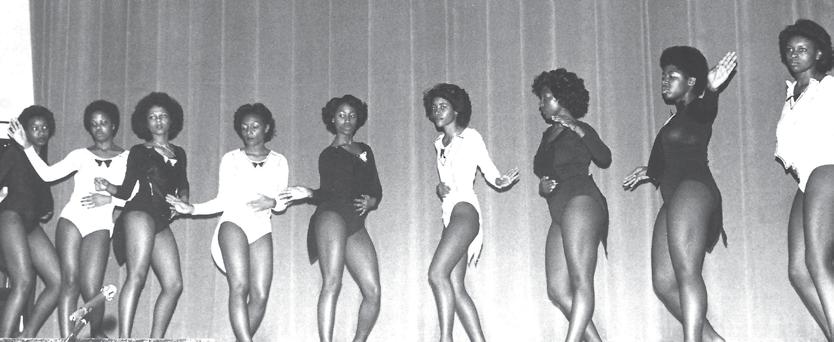 Nancy Davis Smith ’70 Lancaster
Nancy Davis Smith ’70 Lancaster
Editor’s Note: The author wrote that more information can be found at IUP.edu/ charlesdavis
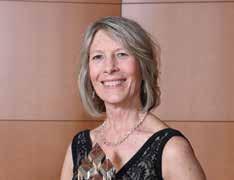
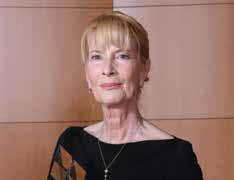

Recipients of the 2023 Distinguished Alumni Awards were honored in April at a gala sponsored by the IUP Alumni Association. The following information is from the time of the award presentation. Video profiles appear at www.alumni.iup.edu.
Whether it be in Asia, Africa, the Middle East, or anywhere else in the world, serving others has been the common thread for Christina Louise Bennike ’88. As executive director of Conflict Recovery International, she coordinates efforts to help vulnerable and marginalized survivors of conflict and disaster through effective sustainable recovery solutions. In previous positions, she did similar work in countries including Indonesia, Iraq, Lebanon, Russia, and the Democratic Republic of Congo. Her journey began at IUP and continued with master’s and doctoral degrees from La Salle University. Groups such as the US Department of State and the American Red Cross have also recognized her for serving others.
For nearly four decades, IUP was part of life for Mary Moore Morgan ’91, a recipient of the Distinguished Alumni Award for Service. After graduation, she began a 30-year career that culminated with her role as assistant vice president for Alumni and Friends. After joining the Alumni Relations team, she took a leading role with a new student alumni association, the IUP Ambassadors, helping it grow to become a respected organization. She also helped develop programs that involved volunteer cultivation and engagement, increased student engagement by connecting alumni and students, navigating changing technology, communicating with a diverse constituent base, and creating opportunities for alumni to stay connected with IUP.
The son of 1949 Indiana State Teachers College graduates, Patrick Cambier ’82 went on from IUP to achieve an Army medical scholarship through the Health Professions Scholarship Program and attend Hahnemann (Drexel) Medical University. He completed an internal medicine residency and a cardiology fellowship at Walter Reed Army Medical Center and held posts including director of the cardiac catheterization laboratory at Madigan Army Medical Center, medical staff president and board member at Morton Plant Mease Health Care, medical director of the cardiac catheterization laboratories at Mease Countryside Hospital, and managing partner of the Heart and Vascular Institute of Florida. A board-certified physician in three specialties, he is a partner with Interventional Cardiology Consultants.
Before creating his own consulting firm, in a career spanning four decades Rich Caruso ’83 started as a certified public accountant and later served as an executive at several companies, including as chief financial officer at Ravenswood Aluminum, Ormet, July Products, and RG Steel; CEO at Neenah Foundry; and COO at Winner Steel. He serves on the boards of VPX Pharmaceuticals, School Specialty, JW Aluminum, and H-D Advanced Manufacturing, as well as several nonprofits. In college, he was active in Student Government and other organizations, and recently, he served on the National Campaign Cabinet. As a Foundation for IUP board member and former president, he helped spearhead IUP’s $245-million Residential Revival.

The IUP Alumni Association board president since 2021, Tonya Anthony Hsiung ’00, M’03 is a recipient of the Distinguished Alumni Award for Service. As program manager and instructor for the National Association of Student Financial Aid Administrators, she trains college and university employees on the administration of financial aid so they can better serve their students. A native of northern Indiana County, she was a graduate advisor to the IUP Ambassadors and was recognized by the Association of Student Advancement Programs. After graduating, she spent nearly two decades working in financial aid at Millersville University and then Franklin & Marshall College before joining NASFAA in 2019.
In 2008, Brandie Smith ’94 came to the national zoo, which she oversees in the nation’s capital. Now, as director of the Smithsonian’s National Zoo and Conservation Biology Institute, she oversees both the 163-acre park, which attracts more than two million visitors every year, and the institute, on 3,200 acres in Front Royal, Virginia, and 30 field sites worldwide. Previously, she held positions with the Association of Zoos and Aquariums and the Dallas Zoo. She is also active in organizations that promote international conservation of wildlife and biodiversity. She holds a master’s degree in zoology from Clemson University and a doctorate in behavior, ecology, and systematics from the University of Maryland.
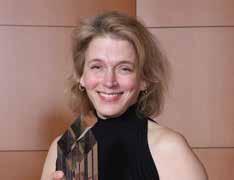

Retired Army brigadier general and current Pentagon senior executive Robin Paul Swan ’78 filled high-ranking activemilitary senior command roles in Bosnia and Iraq and was director, Army Strategy, for the Department of the Army. Retiring after 32 years of uniformed service, he joined the Senior Executive Service at the Tier 3 (lieutenant general equivalent) level and reports directly to the secretary of the Army as director, Army Office of Business Transformation. He earned an IUP bachelor’s degree in geology and was a distinguished military graduate. He continues to support IUP’s ROTC faculty and cadets and was keynote speaker at the program’s 100th anniversary dinner in 2016.
As West Point Band commander, Lt. Col. Daniel Toven ’91,’92 leads the Army’s oldest band. With two bachelor’s degrees from IUP, he earned a master’s at Eastman School of Music before pursuing a master of military art and science at the US Army’s Command and General Staff College. He previously served as deputy commander and associate bandmaster of the US Army Band and as director of the US Army Chorus. He was also deputy commandant at the US Army School of Music. In civilian life, he was founder, music director, and conductor of the Plum Creek Chamber Orchestra and assistant conductor of the Mendelssohn Choir of Pittsburgh.
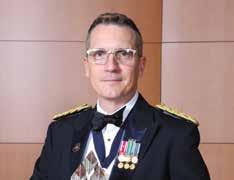
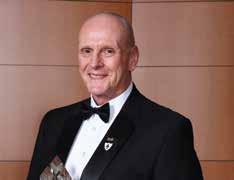
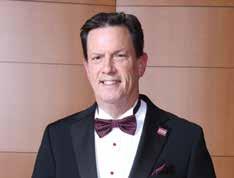
Math can be intimidating. It’s sophisticated, and it comes in algorithms and logarithms. But longtime Virginia educator Gwendolyn Tolbert Best ’93, M’95 shook off math’s pretensions and made it a regular kid’s friend.
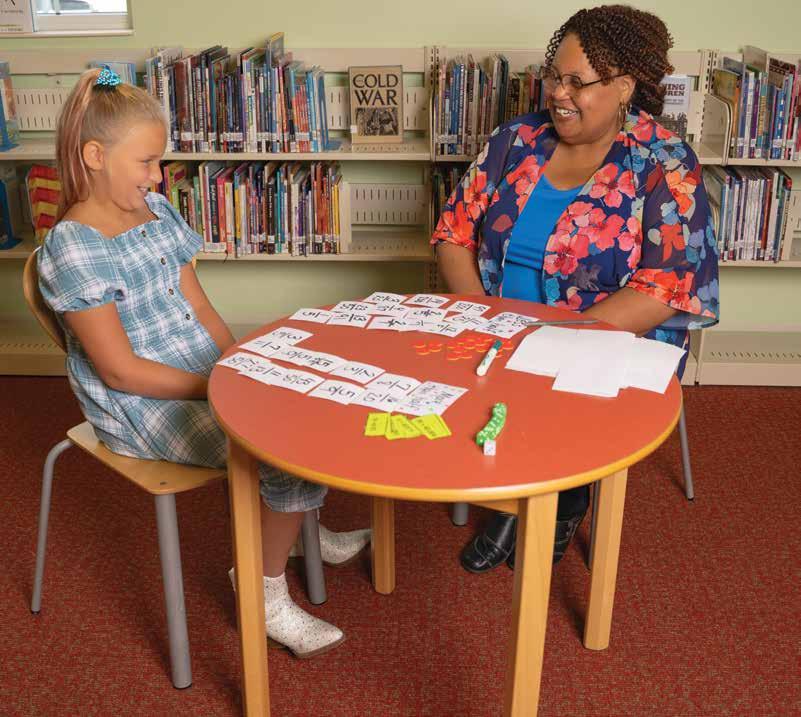
For her students, Best’s math comes in roast beef subs, chili, cappuccino, and tiramisu.
For 27 years, she stamped IUP’s brand of mathematics education on elementaryand middle-school students, on scores of math teachers, and on the statewide math curriculum for the Commonwealth of Virginia.
Best believes in communicating with students and putting mathematics in real-life terms. There’s math to be found at
every turn in their daily lives, she told her students, and she set them on a mission to find those examples and write about them.
The years have proven the success of Best’s approach, which was honed at IUP and bolstered by her fondness for Indiana-area eateries.
Her students immersed themselves in her assignments and rewarded her by returning exceptional numbers in state-administered math proficiency tests.
“I’m a big fan of word problems in general,” Best said. “I’m known for walking around and taking pictures of everything, because I see math in everything.”
In Suffolk, home of Planters’ first massproduction plant, Best spent hours at the local peanut fest and brought back photos of a Ferris wheel, monster trucks, craft booths, and more. Then, she wrote a series of word problems—short stories with embedded math questions—for her students to answer.
Flashing back to her time in Indiana, Best logged on to the website of her favorite IUP-area sandwich shop, 9th Street Deli, to download its menu and create more word problems.
“How much is a 12-ounce soup of the day, a large chef salad, and a BLT?” she asked, and her students used the deli’s menu to calculate the answer. To test them on multiple operations, she posed: “Mrs. Best bought three Italian whole subs and two
small cups of chili. She also requested extra cheese on each sub. How much change will she get from a $50 bill?”
Best came up with more questions that harked back to her student-teaching days in the Penns Manor Area School District, when she often dined at Luigi’s Ristorante in Clymer.

“What is the difference in the cost of a 16inch pizza with four toppings and a 12-inch pizza with five toppings?” she asked, using the Luigi’s menu for reference. “Which costs more: two orders of Yukon-style wings or three orders of garlic toast? How much more?”
Those resources she created have been used so widely and for so many years that it took a fifth-grade class, curious about whether 9th Street Deli was real, to tie the lessons back to her. Last school year, at the urging of her students, Birdneck Elementary teacher Jo Ann Coauette called the phone number on the menu. This eventually led deli owner Josh Muscatello ’06, M’11 to make a trip to the Virginia Beach school. The social media chatter that followed media coverage of Muscatello’s visit identified Best as the source of the math lesson.
Early in Best’s career, Suffolk school leaders promoted her from classroom to office. For a decade, Best was a teacher of teachers. Her personal technique—teaching math with a focus on communication, problem-solving, and reasoning—became a statewide standard.
But the itch to teach drove her back to the classroom, her real love in the world of education.
Best went back to having students create math stories based on themes. She recalled an assignment for her fourth-grade students in 2015 to create a winter- or holiday-themed tale with word problems throughout.
“One student, Jessica Butler, came to school wearing a beautiful candy-cane dress and a fluffy skirt,” Best said. She had dressed as Mrs. Claus to illustrate her math story.
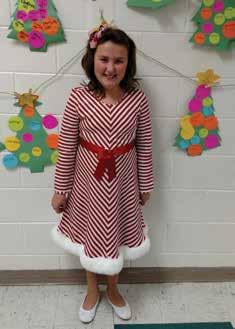
“Her story was called Santa’s Diet. Her outfit represented Mrs. Claus, because the story was written from her perspective.”
Best said her students enjoyed connecting their lives to her writing assignments.
“It also was a way to bring families in,” she said. “My personal vision about homework and projects is that it’s my responsibility as a teacher to prepare kids to do anything I ask them to. I don’t expect them to go home and have their parents do it, but I want the parents to feel like their partners.”
Best’s living math concepts have touched schools across Virginia.

“One of my proudest accomplishments is that I was invited by the state department of education to plan a mathematics Standards of Learning Institute,” she said. “It’s an annual focus on professional learning put on by the state to help teachers understand how they can teach and meet the expectations of the state.”
IUP’s broad influence on teaching standards in Virginia can be traced to Best’s own middle-school years in Mercer County, Pennsylvania.
“My high school guidance counselor thought IUP would be a great place for me,” said Best, who attended Sharpsville Area High School. “She did all the legwork, and before I knew it, I was going to IUP.”
Best said she learned years later that her counselor, Ruth Leone, is an IUP alumna (Ruth Dixon Leone ’65).
It also was not too long ago when she learned that the Sharpsville teacher who fostered her love of math, Barbara Patton— her instructor for seventh-grade math, Algebra II, Trigonometry, and Calculus— also held degrees from IUP (a bachelor’s in 1973 and a master’s in 1978).
“I absolutely adore her and feel certain that my experiences in math with a talented, caring, knowledgeable, IUPtrained educator influenced my decision to specialize in mathematics education [with a master’s degree in elementary- and middleschool math] after earning my elementary education degree,” she said.
As an undergraduate, Best started as a biology/pre-med major, and as a graduate student, she initially studied student affairs in higher education. Both times, she switched to education after one semester.
She also credits her math professors for shaping her love of math and her drive to teach. Larry Feldman, Margaret Stempien, the late James Myers, Jacqueline Gorman, and Mary Enderson, who facilitated Best’s internship in the Penns Manor district, were among them.
“The reason these people were influential for me was their passion,” Best said. “They each had a niche, a special area of mathematics they loved and a perspective about teaching mathematics that sparked a combination of curiosity, determination, and joy in me.”
Best said the effectiveness of IUP’s program was driven home for her once more about 17 years ago, when the school she worked for welcomed five new teachers.
“One day I saw an IUP bumper sticker in the parking lot. I knew it must have been for one of the new teachers,” Best recalled. “Instead of asking who went to IUP, I went into their classrooms and watched them teach the next couple of weeks to figure out who it was. After seeing all of them teach, I looked at one and just said, ‘IUP, huh?’ She said, ‘Yeah!’ Because she was that good. She [Michelle Howley ’05] showed just how stellar the program is for grads and undergrads.”
From a career of teaching students, teaching teachers, and influencing what the state’s next generation learns about mathematics, Best has stepped into yet another role. She works for the Virginia Department of Motor Vehicles, teaching state employees about emotional intelligence, conflict resolution, and communication skills.
Through grants provided by the Virginia Department of Education, she was also part of a corps of educators hired to help students sharpen their skills that had diminished during pandemic lockdowns and remote learning. She tutored six students over the summer.
Best’s vision to guide instructional leaders in bringing out the best in math teachers extends to her volunteer roles as well—on the boards of Reach Virginia and Learning Forward Virginia, organizations that focus on teacher development.
“I have so many positive experiences with teachers and helping them to love teaching math,” Best said. “My heart has always been with elementary teachers, because we have so many subjects that we have to teach.
“No one walks into a classroom with a high level of passion for every single subject. Some are excited about reading but are unsure about their math skills. Or they love science and history, but when it comes to teaching math, they may be just a little apprehensive.
“I love being the person that helps them get good at math and helps them be able to pass it on to their students.” m
2012 after 33 years of service and now lives in Keizer, Oregon.
Gary Buterbaugh ’67, a faculty member who retired from the Computer Science Department in 2005 after 30 years of service, died May 23, 2023.

Aurora Guardiola, who retired from the Department of Foreign Languages and Literatures in 1985 after 20 years of service, died January 11, 2023.
Ralph Johnson, a professor who retired from the Department of Health and Physical Education in 1997 after 25 years of service, died June 8, 2020. He was also a swimming coach in the 1970s and ’80s.
Michael Kosicek ’76, M’79, D’04, a faculty member in the Management Department for 21 years, died July 25, 2023.
Composers from New Zealand have a globetrotting champion in IUP professor and pianist Henry Wong Doe. A New Zealand native who joined the IUP faculty in 2009, he has premiered new works from his home country in London, New York, Singapore, and beyond. His latest project, Perspectives, features the work of six New Zealand composers whom he commissioned to write pieces that reflect their experiences during the pandemic. IUP hosted the world premiere of those works in Gorell Recital Hall in April. See more at IUP.edu/ newzealandworks

“Fire” Felt from Afar
Often called the “Ring of Fire,” the Pacific Rim is known for its frequent earthquakes and occasional erupting volcanoes. Why should people in the eastern US care about these events? A faculty member since 2004, geology professor Jon Lewis explains in a 10-minute video how these geologic hazards can cause cascading disasters that have global impact. Learn more at IUP.edu/ pacificrim
Sherrill Kuckuck, a professor emerita who retired as director of Student Development in 2004 after 33 years of service, died June 24, 2023.
Eileen Master, who taught from 2001 to 2003, died May 8, 2023.
Alphonse Mattia, who taught in the Art Department from 2009 to 2012, died April 10, 2023.
Biology professor Josiah Townsend has discovered more than 20 new species through his fieldwork in Central America. In spite of biodiversity and habitat losses, advances in tools and technology have made these discoveries possible, he said. A member of the faculty since 2012, Townsend chooses names for the species that, in addition to having scientific meaning, have cultural relevance for the people who live where they were found. Learn more in this video from the Innovators series: IUP.edu/newspecies
During her 40 years of university-level teaching, including 15 years at IUP, Rosemary Gido conducted research on topics ranging from jail crowding to the incidence of HIV and AIDS in a state correctional system. Since her 2011 retirement, this professor emerita of criminology has remained active in research—particularly the study of how poverty and lack of opportunity affect Pennsylvania’s incarceration rate. Still the editor of the Prison Journal, Gido has collaborated on research with criminology graduates Cassandra Bullers Reyes ’92, M’04, D’09, Tim Holler ’07, M’09, D’15, Reneè Lamphere M’07, D’12, and Kyle Ward D’15. She has also established scholarships through the Pennsylvania State System of Higher Education Foundation and Misericordia University to help women earn their degrees. Read more about Gido’s ongoing work at IUP.edu/ rosemarygido
Dan Tannacito, professor emeritus of English, recently coedited Autoethnographic Perspectives on Multilingual Life Stories, a work on narrative linguistics. He also took a turn writing his own story, In My Life: A Memoir and Family History. Tannacito retired in

Ruth Morris, a professor emerita who retired from the Administrative Services and Business Education Department in 1991 after 21 years of service, died May 27, 2023.
Daniel Perlongo, a professor emeritus who retired from the Music Department in 2012 after 44 years of service, died May 23, 2023.
Richard Roberts, a professor emeritus who retired from the Physics Department in 2002 after 37 years of service, died July 27, 2023.
Frederick Sehring, a former dean of the Armstrong Campus who retired as an associate registrar in 2002 after 30 years of service, died March 7, 2023.
James Staples, a professor emeritus who retired from the Music Department in 2011 after 44 years of service, died March 5, 2023.
Merle Stilwell, a professor emeritus who retired from the Mathematics Department in 1990 after 23 years of service, died June 11, 2023. He was also a football coach in the 1970s and ’80s.
Monte Tidwell, a professor emeritus who retired from the Professional Studies in Education Department in 2014 after 19 years of service, died August 3, 2023.
Gunther “Gump” Edelmann ’49 celebrated his 100th birthday in August. Emigrating from Germany to the US as a child, he came to Indiana State Teachers College from Johnstown and, a semester later, enlisted in the US Army. Stationed in the Pacific during World War II, he made topographical maps and had a stint playing semiprofessional football in the Philippines. Back at ISTC, he was active in sports and met his future wife, Beverly Wood ’50, now deceased. They had five children. A teacher for 31 years, he started and, for many years, coached the wrestling team at North East High School, for which he was inducted into the North East Athletic Hall of Fame last year.
In their new book, And We’ll All Go Together: An Irish Family Emigrates to America, cousins Marie Lambert McGee ’61 and Michael Lambert ’68, M’69 share the story of their ancestors’ many contributions to this country after their journey “from Ireland to Nova Scotia to Boston and then west.” Marie has worked for accounting firms and as a teacher and consultant in accounting and finance. Michael is executive director emeritus of the Distance Education Accrediting Commission and a 1998 recipient of the IUP Distinguished Alumni Award for Service.
A member of the Indiana State College and IUP men’s basketball teams, Bob Bence ’66, M’67 played for a team from Massachusetts that won the bronze at the 2023 National Senior Games in Pittsburgh. Bob said he owes much of his love of the game to ISTC/IUP coach Herm Sledzik.
A retired professor from Seton Hill University, Audrey Manzlak Quinlan ’67, M’97,
After coming from DuBois to Indiana State College to study art education, Jack Wilson ’67 had a career that took him to Africa and back. Jack first taught in St. Petersburg while working on his master’s in ceramics at the University of South Florida. He and his wife, Bunny, then headed to Kenya, where he worked as an illustrator for the Africa

D’03 had the second edition of her book Gifted or Just Plain Smart? published by Rowman & Littlefield. The new edition addresses changes in the post-COVID educational environment and is a guide for all who work with gifted school-age children. It includes strategies to recognize and develop overlooked gifted students, including those from underserved populations and of various gender identities. She and her husband, Timothy Quinlan ’67, a retired supervisor at US Steel, have two children and three grandsons.
Now retired from the Warren County School District, Jan Garrett ’70 taught driver’s education for more than 30 years and Geography of NonWestern Cultures for nine years.
Inland Mission printing press. Taking his skills east to the Seychelles, he started a ceramics training center for teens who didn’t qualify for high school. He then returned to Kenya and established an art department for the Africa Inland Mission boarding school, where he spent 18 years teaching art and pottery to 500 missionary children. In 2000, the Wilsons returned to Florida, where Jack taught at Panhandle public schools for 12 years. Still tutoring in his retirement, Jack has also built on skills he developed back home in DuBois, helping farmers remove destructive groundhogs. In Kenya, it was baboons. In the Sunshine State— until he recently sold his trap—it was wild hogs. Jack, whose African “fire name” is Gookakihara (bald grandfather), has come full circle.
A member of IUP’s 1968 men’s golf team under coach Bernard Ganley, he was also a longtime coach (with numerous team championships) and official for boys’ and girls’ basketball and for baseball and softball, including Little League.
Last spring, when Johnstown’s Bishop McCort High School performed the musical Anyone Can Whistle, the pit orchestra had help from Michael Bodolosky ’72, M’78, Kevin Eisensmith ’78, Rick Auvil M’91, Josh Hillard ’01, Keith Kuckenbrod ’08, M’09, Jake Kearney ’11, M’16, Megan Hall ’12, M’15, M’19, Dan Hutton ’20, David Earnest ’23, and David Ferguson, IUP assistant dean.
Two conference rooms in IUP’s Kovalchick Convention and Athletic Complex will be named in honor of Phi Sigma
Kappa fraternity. In May, the IUP Council of Trustees recognized the fraternity for its leadership in the Greek community and its contributions to the Kovalchick Complex. Representing the fraternity were Vito Don Giovanni ’72, M’75, D’88; Kim Lyttle ’72, M’74; and Carl Johnson ’73
At its national conference in Jacksonville, Florida, last March, the Association of Teacher Educators awarded laureate status to Terry Tuerffs Vetere ’73, D’01, Slippery Rock University professor emerita. She has been a member of the organization for more than 20 years.
A retired private investigator in Tallahassee, Mike Wynn ’73 said he often helps people reconnect with long-lost friends, including former IUP classmates. He can be reached at mikebwinn@gmail. com.
In his latest book, Burial at Home Plate: An Oddball History of the Pittsburgh Pirates, Bob Fulton ’75 writes about the doubleheader completed underwater, the pitcher who earned a victory while taking a nap, the dead man who tied a franchise record for games played, the Pirates manager who disproved the notion that you can’t steal first base, and the indoor game that was rained out. The book is available through major retailers.
Florida artist David D’Alessandris ’76 capped his 50-year career with a full-gallery exhibition last summer at the Brick City Center for the Arts in Ocala. Titled Retro/New, the exhibit showcased his scope of work in pastels, charcoal, acrylics, watercolor, fiber, paper, wood, metal, ceramics, and found objects. According to a 1980 review of his work, David “can take string, satin, old register paper, chicken wire, magic marker doodles . . . and produce art.”
The Florida retrospective also included the debut of a major new work, India One to Five, a fivecanvas, black-and-white cityscape inspired by his time in India.
Known for his many contributions to the US space program through his work at Martin Marietta, Lockheed Martin, and finally NASA, IUP Distinguished Alumnus Cliff Watson ’74 died June 1, 2023. Cliff worked on propulsion systems for many Space Shuttle missions and received the coveted Silver Snoopy award for achievements in human flight safety and mission success. In retirement, he continued to help with projects including future Mars missions and the return to the moon.

In addition to earning an IUP degree, David did graduate work at Carnegie Mellon.
After more than 20 years in the US Army and 19 years in law enforcement, James Morrison ’77 has retired and settled in Myrtle Beach.
Jack Levic ’79 was promoted to manager of the newly combined story department of Walt Disney Pictures and 20th Century Studios. Living in North Hollywood, he worked in the Disney department for 28 years and now manages a staff of 24 story analysts.
After working in healthrelated research at UPMC for 40 years, during which she had nearly 300 publications in peer-
reviewed journals, Patricia Zipfel Houck ’80 has retired. In addition to her IUP degree in environmental health, she has a master’s in biostatistics from the University of Pittsburgh.
A geoscience professor at Franklin & Marshall College in Lancaster, Dorothy O’Connell Merritts ’80 received one of her profession’s highest honors when she was elected to the National Academy of Sciences. She was one of only 120 chosen for the Class of 2022 and the first from F&M. The academy provides “independent, objective advice to the nation on matters related to science and technology.” Dorothy focuses on the Appalachian midAtlantic region in her research on landforms and the impact of geologic processes, climate change, and human activity on the Earth’s surface.
Last March, Mark McGahen ’81, M’90 was inducted into the Amateur Softball Association of Pennsylvania Hall of Fame. In more than three decades of playing, managing, and organizing events, Mark has led teams to four national championships and 15 state championships and has received numerous individual honors. He is also a five-time gold medalist in the softball throw at the Keystone State Games. Mark retired in 2019 as a faculty member in the Pennsylvania Occupational Safety and Health Administration Consultation Program at IUP.
PNC Institutional Asset Management recently appointed John Shope ’81, M’87 its senior vice president and market managing director for the state of Indiana. He has worked in financial services for 30 years, including as national sales manager of retirement and institutional services for Truist Bank.
Jim Zell ’83 has been named a 2023 Distinguished Engineer at Kyndryl, a leading information-technology infrastructure services provider. Working as an independent contractor after college, Jim consulted with more than 30 companies in payment and
When IUP’s chapter of Phi Mu Alpha music fraternity needed an advisor in 1979, marching band director Charles Casavant, who had joined the faculty a few years earlier, volunteered for the role. Since fraternity meetings were for members only, the brothers asked Casavant to pledge, and, to their surprise, he agreed. Casavant also followed
bank processing and helped install India’s first check processing system in three cities. He also worked in mainframe specialty services at IBM. Recently promoted to global offering manager for IBM zSystems and LinuxONE, Barry Baker ’85 develops and manages hardware and software technical support offerings for clients of IBM’s mainframe platform, mainly in the financial, insurance, and government sectors.
Pittsburgh law firm Buchanan Ingersoll & Rooney has named Scott Angelo ’86 its chief information officer, responsible for the firm-wide information technology and risk management platforms. Scott has also worked for companies in the high-tech manufacturing, government, and financial services industries.
For more than 20 years, Arizona Law Enforcement Outreach and Support founders Jim Hill ’86 and
through on his pledge responsibility to make a paddle for his “big brother,” Kevin Cunningham. More than 40 years later, when Kevin (’80) visited his “little,” he brought the paddle for an updated photo. Read the full story, written by Mary Kreider Megna ’84, of how the fraternity gained a new member and advisor at IUP. edu/phimualpha


Cindy Simcho Hill ’88 have organized programs that bring children, the community, and law enforcement together. Last Christmas, their nonprofit’s Shop with a Cop program helped more than 600 children play Santa for their families. Jim is a former Indiana Borough police officer and IUP Criminal Justice Training Center instructor. Cindy worked in Residence Life at IUP.
Last year, Robert Sinclair ’86 submitted an update about his friend from Germany, Matthias Zimmer, who had taken courses at IUP through an exchange program in the early ’80s. Bob recently reported that Matthias died July 19, 2023, after an extended illness. Matthias was a member of the German Bundestag, or federal parliament, for 10 years. He was also a professor and an author, having published novels in each of the last two years.
Jim Taylor ’86, a former member of the IUP men’s tennis team, and Poom
After reading in the Winter/ Spring 2023 edition of IUP Magazine about the rededication of IUP’s Vietnam Veterans Memorial last November, Rich Golden ’83 (at right, with the umbrella) dug out his snapshots from the original dedication in 1982. Rich also identified, from left, Jack Frank ’58, Career Services and Veterans Affairs
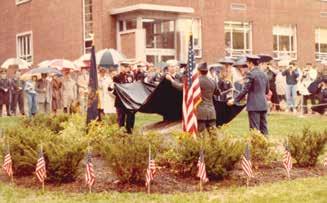
Sunhachawi-Taylor ’87 met at the university’s Maple Street courts more than 30 years ago. In May, the council of trustees approved naming one of the courts in their honor, based on their longtime support of IUP tennis. A member of Indiana Borough Council, Poom was recently hired as director of the Kittanning Public Library. Jim has spent 25 years working for Lockheed Martin and the United Space Alliance on the US space program.
Beth Carlson Cord ’87 was recently appointed vice president, HR Shared Services, for L’Oreal USA. The company established a new Shared Services operation in Tampa to
counselor; Dwight Gaul ’84, M’85; Tim Kochik ’86, IUP Veterans Club president; Pat Crowley ’83; and Karen Greider. He noted that the gold blazer he was wearing belonged to Jack. “I received several of Dr. Frank’s hand-me-downs throughout my four years at IUP,” he wrote.
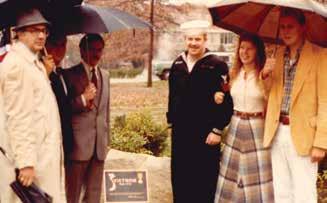
Development specialist. The award is named for professor emeritus Ron Lunardini ’69, who taught in the department for 17 years.
In October 2021, Jill Turney ’87 and Gregory Nanney ’88 were married in Las Vegas by who else but Elvis.
Robert M. Clark ’88, M’92, D’06 has been promoted to professor of criminal justice and social sciences at Pennsylvania Highlands Community College and has been appointed chief of police for the Rockwood Borough Police Department in Somerset County.
The Nashville Business Journal honored Michele Bendekovic ’89 as a 2023 Woman of Influence. Recognized in the Community Supporter category, she leads diversity, equity, and inclusion initiatives at the law firm Bass Berry & Sims.
Seniors in IUP’s Business Honors program traveled to New York City last spring to visit companies, network with alumni, and explore the city. Alumni involved in the trip included Mauro Wolfe ’90, Jim Leda ’95, Leslie Vanderhoof Leda ’98, Amit Patel M’06, Andrew Sandberg ’06, Sarah Hogue ’09, Vishal Vijayan ’09, Nicolas Arino M’10, James Kolenda ’18, Maria Newton ’18, and Seth Thomas ’20.
In January, Karl Sprenger ’91 retired from Clarion University as an associate professor of education.
NASA has selected John Brinkman ’93 as system safety engineering lead for the Power and Propulsion Element, a major component of the planned Gateway space station. He has been a contracted employee at Glenn Research Center in Cleveland since 1995.
IUP trustee Laurie Frisina Kuzneski ’93 presented “Company Culture: Why It’s
support all human resources services for US-based employees.
After 34 years of serving Beaver County, Kevin Lupo ’87 retired from the sheriff’s office in June 2021. He spent his last 12 years as sergeant in charge of operations. In retirement, Kevin works part-time as house manager at the Lincoln Park Performing Arts Center in his hometown of Midland.
IUP’s Department of Student Affairs in Higher Education presented its 2023 Ronald Lunardini Distinguished Alumni Award to Julene Pinto-Dyczewski ’87, M’89, who has worked in Residence Life for 33 years. Jules is the area’s associate director and Training and Leadership
At the Make a Marc exhibit were Marc Fogel’s friends, from left, Bob Lyon ’83, Bill Spencer ’83, Randy Backes ’84, Mark Cipollini ’82, Tom Hartman ’81, and Bob Johnson.
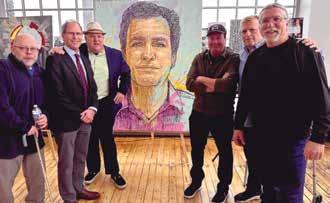
Last spring in Pittsburgh, several IUP alumni visited the Make a Marc art exhibit, which aimed to raise awareness about the plight of Marc “Cubby” Fogel ’84. A Butler native and international teacher, Marc is serving a 14-year sentence in Russia for possession of medical marijuana. In July, friends and family rallied outside the White House, seeking “wrongfully
detained” status for Marc to increase his chances of being released. Members of Congress and the US Senate have also taken up his cause.
On Facebook, the Freedom for Marc Fogel group promotes events and other efforts to help him. His IUP friends encourage joining the group, with the hope that greater participation will spur the administration to act.
In the Audubon Community Nature Center’s 2022 Nature Photography Contest, Pat Frantz Cercone ’85 took top prize in the Adult Community Choice category. Her winning photo, Four-Course Dinner, shows a red fox after an extremely successful hunt. In its mouth are at least four small animals: a chipmunk, mouse, mole, and bird. Pat, who took up wildlife

Important and How to Decide If It’s the Right Fit” last March as part of IUP’s Six O’Clock Series. She highlighted how culturefocused companies evaluate potential hires and what job seekers should consider before accepting an offer.
A former member of the Philadelphia Eagles, Je’Mone Smith ’93, M’96 presented “Leading with an Inclusive Mindset” last spring as part of IUP’s Career Ready Seminar Series. In this interactive session, he explained why the mindset is critical to success in today’s workforce.
At the Madrid Book Fair in May, María Cicuéndez ’94 presented her second novel, Al otro lado del lienzo (On the Other Side of the Canvas), in which a duchess comes out of a painting to guide the main characters in life and love. María also participated in a contest that involved writing a screenplay based on her book. Her first novel, El mensaje de la amatista (Message of the Amethyst), was released last year.
photography in 2019, was in Allegany State Park in New York that Fourth of July when she and her husband saw the fox. She jumped out of the car with her camera and started taking photos. “It stopped only for a second to look at me before it took off,” she said. “Fortunately, I got one decent photo. It wasn’t until we got home and I looked at the photo on a bigger screen that I realized it had four critters in its mouth!”
company’s central and East Coast operations in Florida. Previously, he worked for Envision Physician Services as senior director of operations for anesthesia. He credits much of his leadership and communication style to IUP professor emeritus of sociology Harvey Holtz.
The Journalism Education Association has honored Jane Blystone D’99 with its highest honor, the Carl Towley Award. An advocate for scholastic journalism, she worked as a high school teacher for 34 years and as a graduate program director in higher education for nine years. She is an adjunct faculty member in English at Mercyhurst University and serves as the JEA Mentoring Program chair.
Last spring, the Fairfax County, Virginia, Chamber of Commerce awarded its Bronze Medal of Valor to Michael D’Amico ’00, captain, and his fire and rescue department crew for saving a man just outside a home in contact with a hightension power line. Mike has
been with the department for 23 years.
In 2021, April Boyce Hanahan ’01 was promoted to regional sales director, Northeast, at A. P. MollerMaersk, which provides domestic transportation and related services. April oversees a team of account managers based in 10 major metropolitan areas.
Vienna Wren Lehman was born in January to Cook Honors College graduates Forrest Lehman ’01 and Megan Dively Lehman ’03 and joined big brother Harrison, 9, at home. Megan is regional communications manager for the Pennsylvania Department of Environmental Protection; Forrest is director of elections for Lycoming County.
The City of Philadelphia’s Department of Aviation, operator of Philadelphia International Airport and Northeast Philadelphia Airport, has promoted Stacey Moragne Lennon ’01 to deputy chief administrative officer. Previously, she was executive assistant to the airports’ CEO and chief administrative officer.
In March, Rebecca Pounds Szwalek ’01 attended the Black & Veatch Construction has named Kurt Druzgal ’94, M’13 its Environmental, Safety, Health, and Security program leader. He has more than 20 years of experience in safety and health, including 15 years with Black & Veatch, and has worked on both domestic and international projects, with contracts in South Africa and Southeast Asia.
A project controller for the Gordie Howe International Bridge in Detroit, Matt Murphey ’94 married Paul Georg in December 2021 at TWA Hotel in Queens, New York.
Chautauqua Institution, a not-for-profit education center in western New York, has hired Wade Haubert ’96 as director of Organizational Safety and Security. The institution provides programs and activities focused on the arts, religion, self-improvement, recreation, and more.
American Renal Associates has hired Matthew Grey ’98 as regional vice president of operations, overseeing the
The second annual IUP Swimming and Diving Kickoff Weekend—which doubles as a season kickoff and a get-together for program alumni—is set for November 3 and 4. That Friday’s events include an informal gathering and a welcome reception with remarks by coach Chris Villa. Those attending are asked
to bring old photos and memorabilia. Saturday’s schedule includes the Ralph Johnson Invitational, a meet and greet with the current team, and a postmeet tailgate. That Sunday, IUP will host clinics for prospective college swimmers and coaches. Last year, more than 100 swimming and diving alumni attended the kickoff, which honored the late Ralph Johnson, coach from 1971 to 1982. Among those in attendance were Johnson’s daughters Donna Johnson Miller ’86, pictured at left, and Deborah Brandt, as well as early team members Jim Hoover ’74 and Joani Santoleri Diorio ’80. Find event information at www.alumni.iup.edu

Women in DSO (Dental Support Organizations) conference in Las Vegas as one of five finalists for the Clinical Leadership Award. She is a dentist and regional doctor mentor of operations for Heartland Dental.
Matthew Gergely ’02 was elected to the Pennsylvania House of Representatives in the 35th District (Allegheny County) and was sworn in on February 21.
In June, Stephen Eberle ’03 was confirmed as US marshal for the Western District of Pennsylvania. After retiring from the Pennsylvania State Police as a commander, he served as regional director of Secure Community Network, the official security organization for the North American Jewish community.
Virgil Films and Entertainment has promoted Tim Maggiani ’06 to copresident. Previously, he was vice president of Digital Services. The Philadelphiabased company’s recent projects have included the film High Expectations, starring Kelsey Grammer, the Holocaust documentary Return to Auschwitz: The Survival of Vladimir Monk, and the biographical documentary Anne Murray: Full Circle
An associate professor of sociology and criminal justice at the University of North Carolina, Reneè Lamphere M’07, D’12 is coeditor of Survivor Criminology: A Radical Act of Hope, published by Rowman & Littlefield in 2022. Part of the Applied Criminology across the Globe series, the book explores crime and justice through the lived experiences of survivors.
In March, Corey King D’08 started work as the 18th chancellor of the University of Wisconsin-Whitewater. Previously, he served as vice chancellor for inclusivity and student affairs at UW-Green Bay. In addition to his IUP doctorate, he holds bachelor’s and master’s degrees from Florida State University.
As part of IUP’s Empowering Women Series last spring, Lydia Robinson ’08, Shantel Wilkins ’16, and Nichole Sesti spoke on their journeys as entrepreneurs. Lydia is the founder of a production company, Shantel is an instructor and salon owner, and Nichole owns and operates a vintage clothing shop.
A native of the state of Indiana, Arnold Ivey CA’02 took what he learned at the IUP Academy of Culinary Arts and went on to open several restaurants built around his recipes and techniques. Now the executive chef at IronRock Tap House in Greensburg,

he is the owner of a line of seasonings and was a 2020 participant on Guy’s Grocery Games on the Food Network. In the video Cooking Up a Career, he shares how IUP provided key ingredients for his success. Watch at IUP. edu/arnoldivey.
A well-known couple in the IUP community, Alan Luckey ’87, M’89 and Rhonda Luckey recently started a company that makes a tool to help weavers

with their looms, specifically with threading the heddles and treadling the weaving pattern. Through a grant from the Pennsylvania Council on the Arts, the Luckeys’ company, called the Weaver’s Perfect Memory, donated one tool each to four Pennsylvania studios, including the Artists Hand Gallery in Indiana. Rhonda is a longtime fiber artist and retired IUP vice president for Student Affairs. Alan, the tool’s inventor, is an educator, engineer, builder, artisan, and musician. He was a member of the music group the Folkmen, which was popular in the 1960s at Indiana State College and later IUP and which played throughout Pennsylvania and New Jersey.
Growing up in Penn Run, Indiana County, Lindsay Ward thought she needed to go to a city to get an education that would prepare her for a career in broadcasting. But, she found that IUP’s Communications Media Department and its student-run TV station gave her the start she needed. Lindsay (’08) joined KDKA-TV in Pittsburgh in 2019 and was promoted to morning news anchor last year. In the video Lights, Camera, Passion, she discusses the job she loves and how IUP helped her get there. Watch at IUP.edu/ lindsayward

The director of orientation, transition, and family programs at Salisbury University, Joe Benyish M’12 received the National Association for Campus Activities Legacy Award, which honors NACA leaders for their service. Joe recently served as Mid-Atlantic Regional Leadership Team chair. Seton Hill University has appointed David von Schlichten D’12 as dean of its School of Humanities. A faculty member at the university for 15 years, he previously served as associate professor of religious studies and coordinator of the Gender and Women’s Studies program.
Last spring, IUP’s Theaterby-the-Grove presented A Blossoming Romance, cowritten by Joe York ’12. The musical tells a story of acceptance and inclusion, as the main character starts a relationship with a woman he later discovers is a flower.
Fittingly, it was Mother’s Day, May 8, 2022, when Lauren Mough Carter ’13 and Kevin Carter ’13 welcomed their son, Cooper.
A popular pasta chef on social media, Ryan Peters CA’13 amazed viewers in June by creating a batch of pasta that
incorporated some 10,000 eggs. He began posting his pastamaking videos on TikTok in 2020, and the following year, he quit his job to focus on creating social media content. That has included a series in which, for each new installment, he doubles the number of eggs in his pasta. All the food is donated to charity.
Coordinator of the internal medicine residency program at Virginia Commonwealth University Health, Henry Lewis M’14 returned to IUP during Black History Month in February to speak on addressing the key risk factors for health problems in Black communities.
After four years of working for Washington County Juvenile Probation, Franklin Morris ’14, M’15 has accepted a job with the US District Court. He said he will miss guiding youth and projects to clean up the Monongahela Valley and other communities.
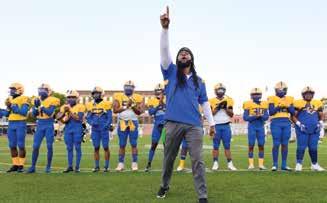
The US Navy recently recognized Petty Officer 2nd Class Brenden Goff ’16 with the Blue Jacket of the Year Award for outstanding service as a junior sailor. He is a flutist in the US Fleet Forces Band in Norfolk, Virginia.
Political theorist and security analyst Reza Parchizadeh
D’18 participated in the Pirate Party of Europe’s Security
Conference in Munich last February. Speakers from around the world addressed topics such as European Union foreign policy and Ukraine’s war with Russia. Reza spoke on the revolution in Iran and how it demonstrated the people’s desire for democratic change.
Pianist Sicheng He M’20 returned to IUP in March to give a recital and master class. He is a doctor of musical arts candidate at James Madison University.
As a senior during the coronavirus pandemic, Nolan Grimes ’21 began research that led him to write and selfpublish a book, A History of Buildings at Indiana University of Pennsylvania, released in spring 2022. He said that using the IUP Archives for this project and volunteering at his local historical society helped him land a job as Facilities Archives and Geographic Information Systems manager at Carnegie Mellon University. His book is available through Amazon.
Cook Honors College graduate Maddison Hendricks ’21 has been awarded a Fulbright to spend nine months teaching English at a school in the Asturias region of Spain. She said she is excited to gain experience teaching music and

Spanish and teaching English to speakers of other languages. After graduating from IUP, she taught seventh-grade Spanish at Newark Middle School in Newark, New York.
A writer and translator from Jordan, Ashraf Mansour D’21 wrote that his research interests include postcolonial studies, comparative literature, diaspora, women’s studies, feminism, human rights, democracy, and cultural studies. His most recent research papers are “Arab Diasporic Women between Challenges and Opportunities”
and “Is Diaspora the Solution for Women to Obtain their Social Rights?”
In fall 2022, while finishing coursework for her IUP master’s program and raising her family, Erica Zamborsky also completed an internship at the White House in the Office of Management and Budget. She earned her bachelor’s in accounting from IUP in June 2022 and her MBA in December.
Texas MD Anderson Cancer Center, considered a top US hospital for cancer care. Leslie had medical school in her initial plans, but in her later years at IUP, she took business classes that led her to reimagine her future, to get a master’s in health administration from George Washington University, and to steer toward the career she now loves. She said her experience on the basketball team has served her well professionally as she and her colleagues at MD Anderson work together toward one mission—to eliminate cancer in Texas, the nation, and the world. Read more at IUP.edu/lesliestapleton.
Through
and working in marketing for Pittsburgh Fashion Week, Jordan Brown ’22 arranged for more than 20 IUP Fashion Studies students to volunteer at the organization’s fall 2022 show. There, they assisted designers and helped with hair, makeup, and show production. Four got a chance to model. Based on that experience, the relationship between the organization and the IUP program is expected to continue. A model in Allegheny County since she was 16, Jordan now focuses more on sales and on building her own business, Mozell Fashions. Read more at IUP.edu/jordanbrown

Davie, Esther Wood Marshall, William Miller, Alan Smith, Jerry Westover
1960
Carole Baker, Jack Denny, Shirley Allen Hapsic, Jesse Mills
1961
Murnaghan Carns, Daniel Daily (M), Marcia Kearney Grimm, Nancy McCullough Knight, Ann Chambers Leet, Greig
Mitchell, Barbara Raibourn
Pearl, Bradley Reiter, Richard Stahl (M), Mary Wallace
1985
Karla Border Blake, Donna Leng
Nahouraii, Todd Tremont
1986
Frank Emerick (AA), Brenda Firestone Schmidt
1987
The following alumni deaths were reported between January 1 and June 30, 2023.
1943
Hilda Knepper Cobb, Jean Long
Sidoroff
1944
Pauline Otto Tindal
1945
Marie Graff Miller
1946
Velda McHenry Grandjean, Eleanor Wilson Krebs
1948
Ruth Grahn McNaughton
1949
Dennis Cambier, Peggy Cox Frankenfield, Joan Truzell Long
1950
Marcella Weyer Mankamyer, Erla Weaver Seacrist, Robert Traugh
1951
Louise Brooker Hackett, John Kucaba, Fern Deturck Ritter, James Scott
1952
Jean Weimer Gardner, Richard Magner, Robert Rehm
1953
Vernon Mauk, James Spodnik
1954
Andrew Smith, Patricia Hobaugh Wainwright
1955
Richard Barkley, Mary Ellen Whitlatch Grubb, Martin Ide, Norma Paustenbach Oakes, Kathleen Pebley, Dorothy Valko
1956
James Shea, Nancy Hesselgesser Sutton, Sara Lunn Turley, Marjorie Schrader Vatter, Leo Vroble
1957
Carol Rapp Fausti, Alyce Marshall Fellows, Lois Baker
Kratzer, Nancy Zebraskey
Nelson, Robert Prindle, John
“JD” Varner
1958
Marian Smith Denny, Richard Dillman, Larry Hawn, Raymond Hennessey, Leo
Lenze, Martha McGeary Pifer, Jacquelyn Rusnak Walsh
1959
Joann Schmucker Bennett, George Boris, Maureen Burns
Brenda Davis Brown, Joselyn Molleca Czap, Ann Williams Klemm, Paul Kurtz, Stanley Maliszewski, Theodore Medvetz, Louis Pisani
1962
Duane Cipollini, Nelson Sell, Barbara Shaeffer Shearer, Patricia Stewart, Anita Gray Tortorella
1963
Alfred Bish, Helen Moffitt Kaiser, William Klein, Thomas Moore, Richard Overdorff, Mary Castafero Ross, Ronald Smith, Larry Sobotka, Frank Swalga
1964
Nancy Lee White Cannin, Eugene Capizzi, Amy Fisher Maxwell, Carol Cogley Watters
1965
Donald Begalke, Delores Kokoski Behun, Gordon Lantzy, Paul Popely, Ethel Cagley Steele, John Swanson
1966
Lawrence Adams, Thomas Campisano*, Rita Davis-Geist, Charles Harpster (M), Larry Kaufman, Susan Kerr, Roxanne McQuillen
1967
Gary Buterbaugh*, Phyllis Hartman, Allan Kirschman, Judith Richards Laughrey, Charles Paoletti, Joseph Rura, Frank Strelec, Thomas Valenti
1968
John Bloomquist, Howard Bush, James Hritz, Janice Mitchell (M), Richard Shaffer (M), Dwight Smith, Mary Knechtel Steiner, Michael Yasick
1969
Mary Onofaro Archey (M), William Boucek, Jacqueline McCauley Fetzer (M), Joseph Harosky, Doris Leibfreid (M)
1970
Mary Brown, Gloria Barrett Fyock, Susan Keating Krenisky, Vicki Rimoldi Morgan, Daniel Rentel, MaryAnn Holmes Sanderson, Kathryn Skemp, Samuel Strong (M), Ann Yurcisin
1971
JoAnn Long Al Ameer, Steve Andrascik, Lance Benton, Linda Lumadue Burke, Susan
1972
William Calhoun, Bonita Arndt
Close, Patricia Somple Curry, Robert Diehl, Janis Keeney Hoffman, Paul Peles, Thomas Stephens
1973
Elizabeth Cooper Depp, Diane Mildrew DeStephano, Barbara Elling Raper, MaryLou Morris Suckling
1974
Lynne Dixon Brown, Marybeth Cook, Karen Collier Gibbons, Kenneth Greenwald, Edward Hauck, David Hoover, Loren Inserra (M), Robert Koch, James Layman, Deborah McKenery, Michael Ocilka, John Schlemmer, Clifford Watson, Lucille Yakulis
1975
David Drumheller, Charles Hauris, David Jefferson, Nancy May Kriek, Jeffrey Young
1976
Charles Ailes, Lynn Hollenbach Fleming, Marimichael O’Halloran Skubel
1977
John Dobos (M), Terrence Gaworski, Thomas Kinzler, Cheryl Smith Teamann
1978
James Arnone, Robert Flora (M), Judith Matz Krinks, Denise Kummick, David Miller (M), Phylis Pietrusza (M), Cynthia Hoff Tanner, Barbara Sendry Turiak (M)
1979
David Cooper, Mary Cecconi Diulus, Michael Horner, Richard Roukous, Robert Simon*, Cynthia Weber, Richard Zielinski
1980
Diane Reitz, Sharon Rider
1981
Colleen Crytzer (M), Karen Coologhan Deneweth, Helen Harrison (M)
1982
Susan Hall Kelly, Randi Dobkin Rubin, Heide Wightman Sedwick (M)
1983
Laurie Detling Deery, Philip Ginyard, Mary Hopper (M)
1984
James Benedetti
David Gallo, Barbara Martin (M), Marie Pella, Jeffrey Sell, Mary Louise Sibert (M)
1988
Terry Glasser, Barbara Grundy Vantil
1990
Jason Caplan, Barbara Grogan Savino (M), John Serro, Rachele Johns Wright
1991
Jay Bandieramonte, Joseph Silveri
1992
Sandra Hedstrom, Mildred Rethi (CA)
1993
Sue Kreidler (M), Keith Little (M)
1995
Joanne Greendoner, Robert Kollar (M), Shirley Farester
Lukehart, Mary Renz
1996
Harry Christner, Lisa Iacobucci Swiatlowski
2000
Alexis Hippenstiel Breen, Douglas Klug
2001
Minerva Fyock Russell*
2002
Melissa Lincoln, Joshua Mottillo, Christina Lukehart
Perry
2004
Ronald Fisher, William Kane, Abigail Skinner (M)
2006
Albert Simon
2007
Christopher Gleason (M)
2009
Brian Rougeux
2010
Amy Raabe
2012
Thomas Bronson
2013
Stephanie Auguste, Matthew Scott
2016
Richard Zurawa
2018
Joshua Kuzmyak
2023
Glenn Porter
*current or former faculty member, staff member, or administrator
By completing and mailing the form below, you help IUP keep your records up to date and IUP Magazine coming to you. Doing this also ensures that the information reaches the magazine. If you’d prefer to save a stamp, you’re welcome to send the same information to the magazine’s editor at iup-magazine@iup.edu or simply complete the online form at IUP.edu/magazine.
Name
Maiden name
Address
Graduation year
Home phone ( )
Business phone ( )
Email address
Job title
Employer
(Check one or more)
Spouse’s name
Spouse’s maiden name
Spouse’s grad. yr. (if IUP)
Spouse’s job title
Spouse’s employer
Phone ( )
IUP retiree: faculty/staff Years
News
Jill Turney ’87 to Gregory Nanney ’88, October 10, 2021.
Matthew Murphey ’94 to Paul Georg, December 28, 2021.
Carly McPartland ’11 to Jeremy Biroscak, August 19, 2023. Jenna Enright ’13 to Don Taylor, October 9, 2022. Kayla Jones ’13 to Gary Cramer, September 1, 2018.
I/We would like to make a gift to help defray the cost of publishing IUP Magazine (Please make checks payable to the Foundation for IUP.)
Here is news for All about Alumni (Class Notes, Lost and Found, Weddings, Arrivals, or Deaths) or Mentors. I understand it may appear in both the print magazine and online.
Please note: News that appears in Class Notes for this issue arrived in the magazine office by July 30. If your news came in after that date, it will appear in the Spring 2024 issue. Submissions for the Spring issue must arrive in the magazine office no later than January 19, 2024. News arriving after that date will appear in the Fall 2024 issue. News for All about Alumni, Weddings, and Arrivals must be reported either by or with the explicit approval of the subject(s). Photos become the magazine’s property and may or may not be returned. The magazine does not report engagements or pregnancies.
My/Our address is new. ____ I/We get more than one magazine. Enclosed are labels.
Signature
By signing this form, you have authorized the university to make changes to your biographical data. These changes affect all personal and academic records (including your transcript) maintained by the university.
Mail to Elaine Jacobs Smith, IUP Magazine, John Sutton Hall, Room 301, 1011 South Drive, Indiana, PA 15705 or send this information via email to iup-magazine@iup.edu.
Note: In cases in which an IUP degree beyond the bachelor’s degree was earned, only the bachelor’s degree is indicated. Deaths of faculty members are reported in the Mentors section of this issue.
James Buterbaugh, who retired from Maintenance in 2010 after 22 years of service, died June 10, 2023.
Rebecca Young Driscoll, wife of President Michael Driscoll,
who worked in many roles at the university and in the community from 2012 to 2022, including as a volunteer tutor in the Kathleen Jones White Writing Center, died January 1, 2023.
Tonee Ellis, a senior majoring in biology, died August 1, 2023.
Peter Hannak, who retired from Custodial Services in 1999 after 25 years of service, died May 19, 2023.
Joseph Serian, who retired from the Grounds crew in 2019 after 15 years of service, died May 8, 2023.
Darl Somerville, who retired from the Facilities Management Department in 2002 after eight years of service, died June 15, 2023.
Julie Wannett, who worked in Campus Dining and retired from Housekeeping in 1994 after 11 years of service, died July 16, 2023.
To Forrest Lehman ’01 and Megan Dively Lehman ’03, a daughter, Vienna Wren, January 17, 2023.

To Kevin Carter ’13 and Lauren Mough Carter ’13, a son, Cooper, May 8, 2022.
To Kayla Jones Cramer ’13 and Gary Cramer, a daughter, Delaney, September 14, 2019, and a daughter, Jacquelyn, January 31, 2023. To Emily Case ’12, M’13 and Nicole Rybar ’12, M’13, a daughter, Callie Alexandria, November 12, 2022. To Stefanie Stitely Pastors ’13 and Dustyn Pastors, a daughter, Penelope, December 23, 2022.
For years, Stephen Shiring ’81, M’85, a professor in the Hotel, Restaurant, Tourism, and Event Management program, has watched students return from internships transformed—confident in their abilities, engaged in the classroom, comfortable with communicating. Now he believes students can develop valuable skills that normally come with real-world experience through a simulated hotel front desk in the Eberly College of Business.
Made possible through a $125,000 grant from the Statler Foundation, the desk was ready for the start of the fall semester.
Nicole Buse ’12, M’13, D’20, who joined Shiring on the faculty 10 years ago, said students in her Hotel Operations class next spring will use the desk to role-play real-life scenarios provided by the American Hotel and Lodging Association. Examples include customers charged an amount at odds with their online booking price or guests trying to check in without ID or with a different
credit card from the one they used to book the room.
Last spring, Buse’s students conducted this role-play from behind a podium at the front of the classroom. She thinks the new, realistic desk will help “put them in the mindset that they’re really at the front desk of a hotel.” She’ll also require them to dress the part. “You take it more seriously and feel as though you’re actually in that role,” she said.
In addition to building their skills, the real-life desk shows students that IUP is invested in their education, Buse said. Next spring, she plans to implement online case simulations, which will further immerse students in the practice of hotel management. They’ll carry out operations such as checking which rooms are available and establishing room pricing based on what’s happening around them, like a convention in town or an inclement weather event.
Shiring said his inspiration for the hotel desk was the Allenwood, the campus restaurant that for decades has given students in his program hands-on experience in the food and beverage industry. “I’ve always been trying to build
that hotel side and find what could set us apart,” he said.
Before pursuing the project, Shiring asked IUP alumni who work in the lodging industry whether a hotel front desk is still relevant today, given keyless entry and other new technology. “They said yes, it’s still the focal point of the hotel.”
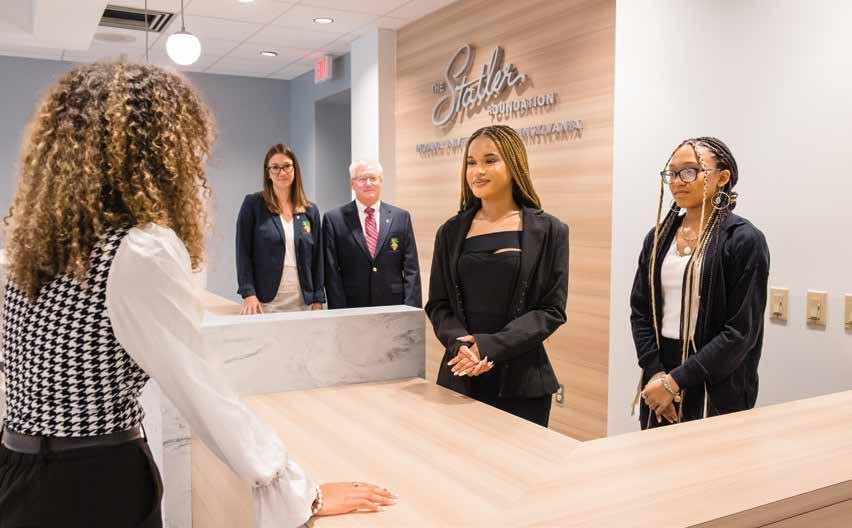
He credits Chris Koren, IUP’s director of Strategic Partnerships, for building the relationship with the Statler Foundation, which has awarded two scholarships to IUP students in addition to funding the hotel desk. The foundation was established through hotelier Ellsworth Statler’s will, which designated funds for improving the industry.
IUP program faculty members believe hands-on learning opportunities—like the two internships required of each student and the new hotel desk—are key to that improvement.
“We want students to have real-world experience,” Buse said. “We also want to offer as much real-world experience as we can in the classroom.”m
More than a thousand miles from the commonwealth where they grew up and went to college, six IUP alumni are paving the way for future IUP students. These alumni live in Texas, and the students they help could be from any state; nevertheless, strong ties to IUP on all sides defy geography.
Together, these alumni have created the Texas IUP Alumni Scholarship for full-time, upper-class students. All of the graduates can recount personal, heartfelt stories of how IUP changed their lives.
According to one of the donors, Jeff Swift ’75, “We all got an excellent education at IUP. Unfortunately, our businesses took us far away from Pennsylvania and didn’t allow us to be as involved with IUP as we would have liked.”
“This scholarship gives us the opportunity to give something back to IUP,” said Don Baronitis ’76, another of the donors. “Most of us received financial help when we were at IUP, and we want to help students so they, too, can be successful.”
Swift was a business management major who came to campus from Pittsburgh. He
is married to another donor group member, Jill Trainor Swift ’75, a consumer services graduate originally from Penn Hills.
Baronitis came to IUP from Baden, Beaver County, and majored in management. Another Eberly College of Business alumnus, business administration major Dale Hosack ’81, is from Greenville, Mercer County. His classmate Greg Schockling is from Beaver Falls and majored in accounting. Rounding out the donor group is 2011 IUP Distinguished Alumni Award recipient Elizabeth LaTorre Travis, a 1965 biology graduate from Wilmerding.
“In addition to supporting students, we hope this gift will serve as a model for other alumni groups and that it will enrich and strengthen our own group,” Hosack said. “Not everyone has the individual means to create an endowed scholarship, but this is a great example of a group of dedicated alumni coming together to accomplish a goal.”
All the alumni live in or near the Houston area. Bellaire resident Baronitis is retired from the corporate office of Waste Management. Houston resident Hosack works at Western Container Corporation.
The Swifts live in The Woodlands; Jeff is retired from HMT, Inc., and Jill formerly worked in customer service at Mobay Chemical. Sugar Land resident Schockling is retired from Sequent Energy Management. Travis has a PhD and is on the faculty at the University of Texas MD Anderson Cancer Center.

Starting with their initial investment of $25,000, group members hope the scholarship will grow with more donors from Texas. They also want to inspire alumni in other places to band together to establish their own scholarships. IUP, they believe, is deep in the heart, no matter where that heart is.
If you would like to support the Texas IUP Alumni Scholarship or to transform lives through another fund, please call the University Advancement office at 724-357-5661 or email iup-giving@iup.edu
From left: Jeff and Jill Swift, Greg Schockling, and Don BaronitisSUTTON HALL, ROOM 301
1011 SOUTH DRIVE
INDIANA, PENNSYLVANIA 15705-1046
WWW.IUP.EDU /MAGAZINE

4005851001
CHANGE SERVICE REQUESTED